Special Report
The Biggest Fads and Trends in Food and Drink Since 2010
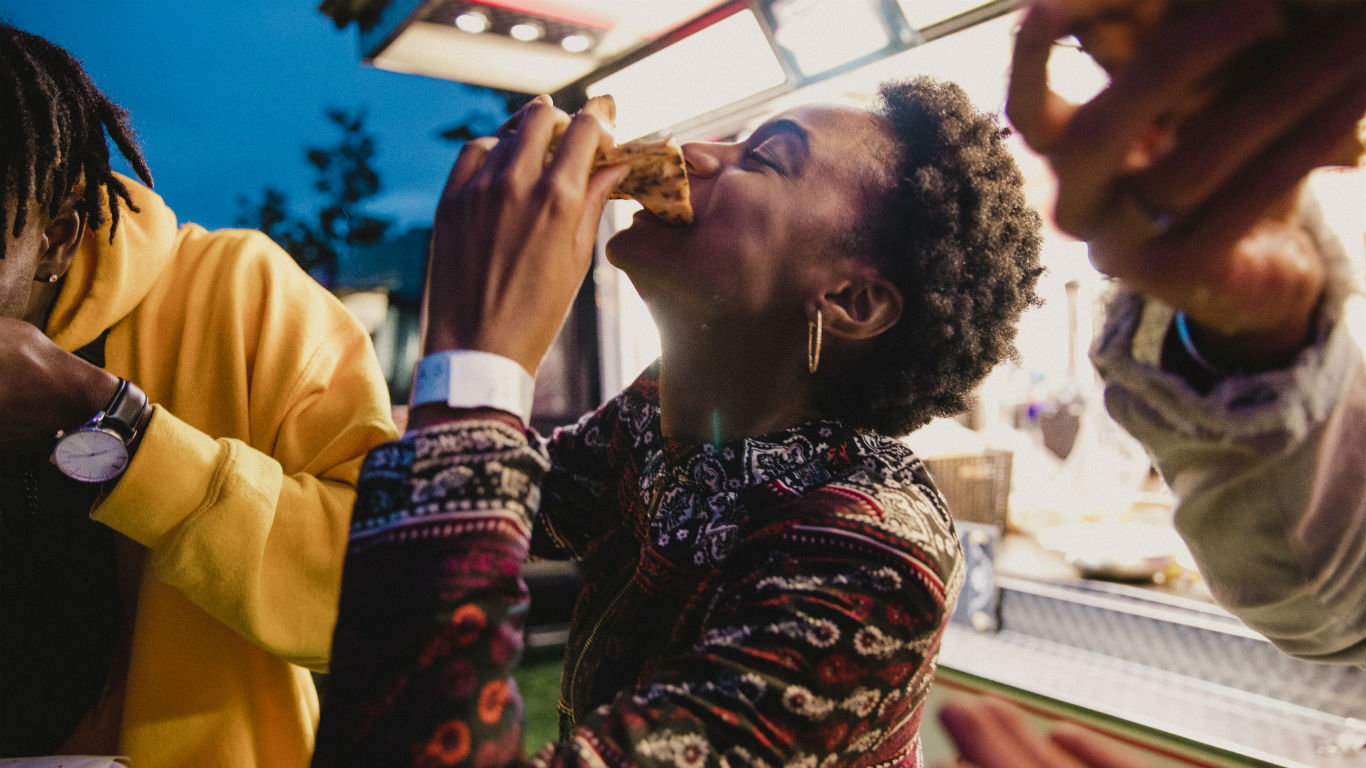
Published:
Last Updated:

As in most other areas of human endeavor, fads and trends come and go in the world of food and drink. It isn’t always easy to tell the difference between the two, but trends are basically the fads that stick around. Though they often take time to build, they eventually end up changing things about the way we eat and drink, or think about eating and drinking, more or less permanently — or at least until other trends displace them.
Fads are more ephemeral; they come and go. More than a century ago, an article in the Journal of the American Medical Association defined a fad in part as a “trivial fancy adopted and pursued for a time with irrational zeal.” (The term’s etymology is uncertain, but it might derive from the Latin “fatuus,” meaning “stupid.”) Trends are fads with legs; they lend fads legitimacy, proclaiming that they weren’t perhaps so trivial after all.
Diets — paleo, keto, etc. — can be fads or trends; so can indulgences like fast food mashups (the Doritos Loco taco) or milkshakes with such crazy toppings as cotton candy or caramel apples. Fads from recent years, such as plant-based meat and Middle Eastern food — both included here — have evolved into full-scale trends, and are now virtually part of the mainstream.
Click here to see the biggest food trends since 2010.
It remains to be seen whether such innovations as artisanal toasts, hard seltzer, and rainbow-colored foods are here to stay, but some food and drink trends have definitely altered the culinary landscape and even our very lifestyles overall. These are the lifestyle trends you need to know about this year.
The “camera eats first” (shoot it before you eat it) phenomenon, for instance, has greatly influenced not only the social media on which food photos appear but the way chefs cook. Foods infused with cannabidiol (CBDs) are probably here to stay, too, as are, almost certainly, food delivery apps, food trucks, and, inevitably, everything pumpkin spice.
It’s easy to see how long-lasting fads that grow into trends can be when you consider the biggest food fads of the past 50 years.
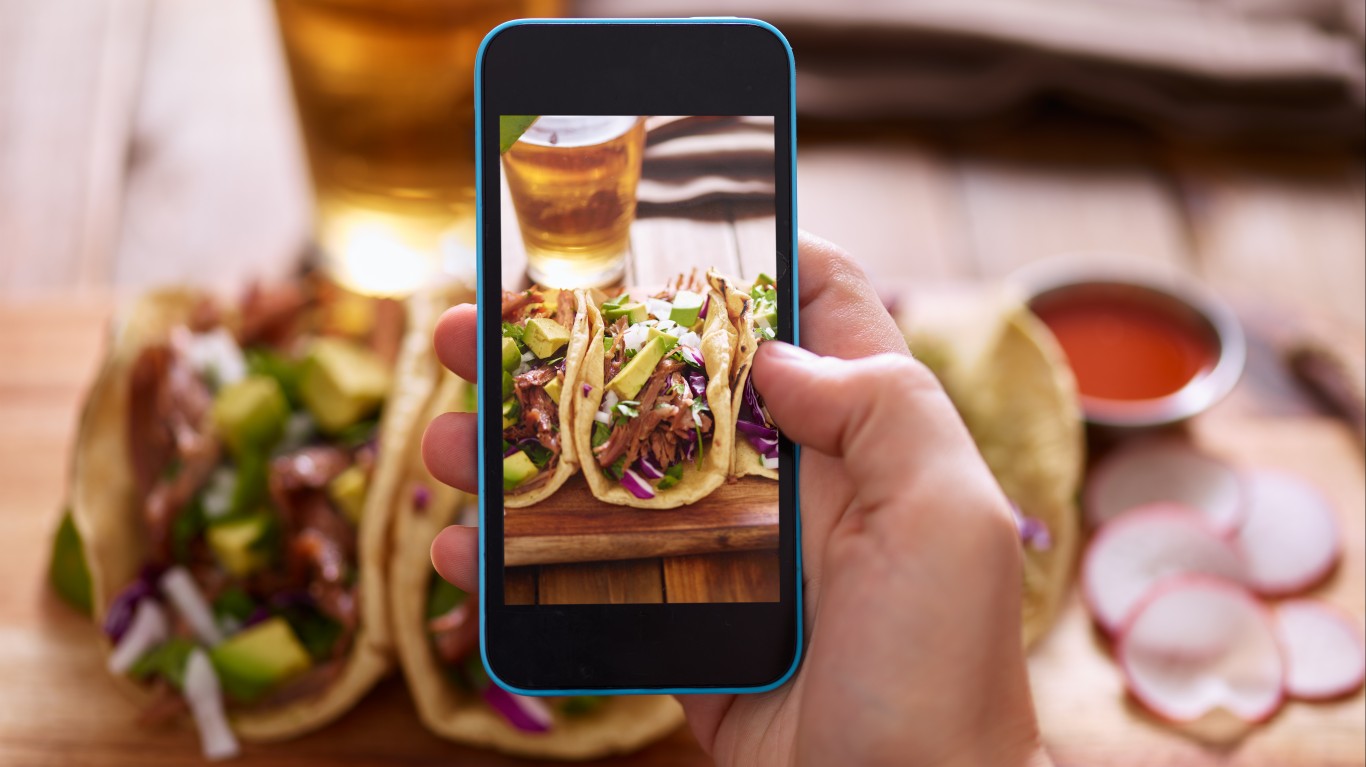
“Camera eats first”
The first food photo on Instagram — before it was even called Instagram — was posted from a taco stand in Mexico by the app’s co-founder and CEO Kevin Systrom in mid-2010. Today, more than 130 million Instagram posts are hashtagged #foodporn. By 2013 articles were being written about the influence of Instagrammers on chefs, with the phrase “camera eats first” — meaning take a picture before you take a bite — used as early as 2015. A survey conducted in 2017 by the market research company Maru/Matchbox found that 69% of those aged 18 to 34 took a photograph or video of food they were about to eat and posted it on social media. (The percentages dropped significantly to 45% for 35- to 49-year-olds and 21% for those over 50.)
[in-text-ad]
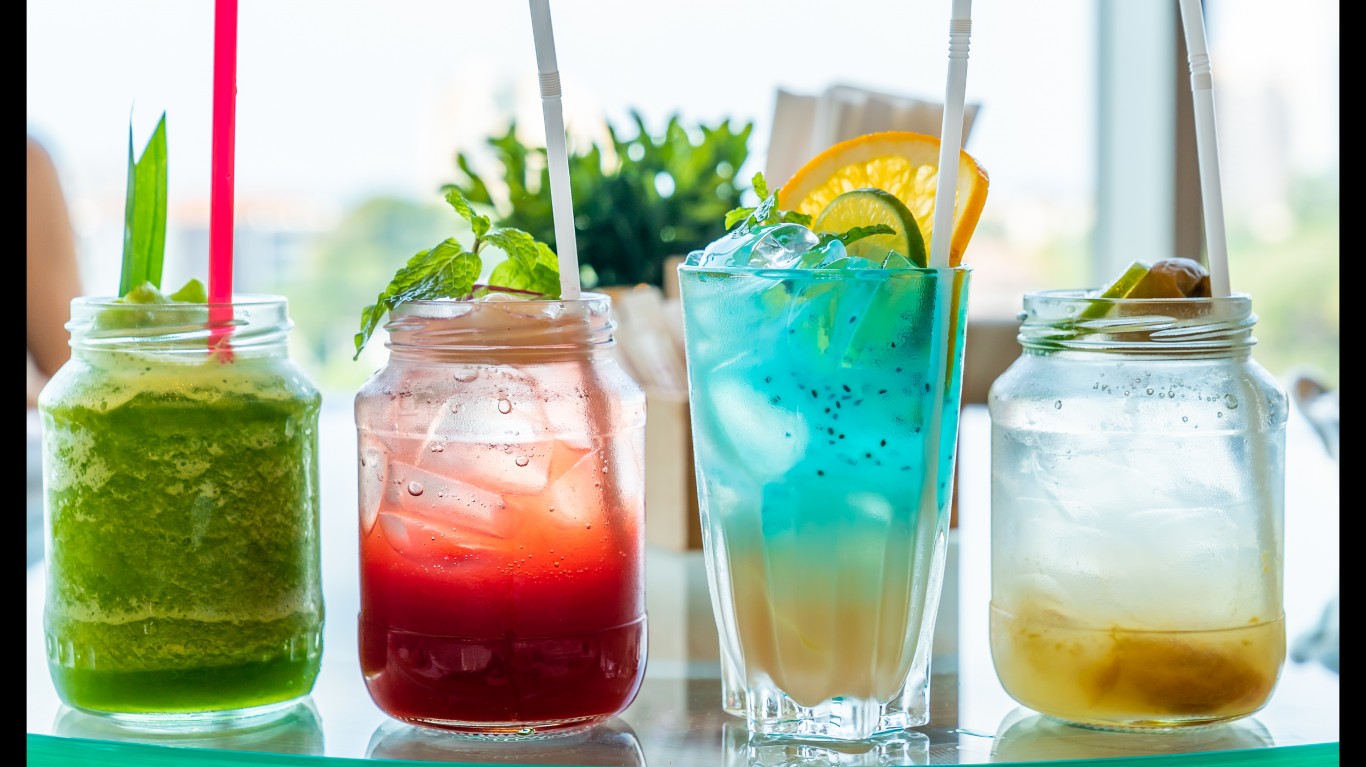
Sober curiosity
It all started with the “Dry January” movement, launched in 2012 by the British alcohol awareness group Alcohol Concern. The movement migrated to the U.S. soon afterwards, and it is said that one in five Americans now participates. Dry July and Dry September have started gaining traction too. As NPR put it, “[A]cross the U.S., …people are challenging each other to see what life is like without alcohol…” This doesn’t mean that people are turning wholesale into teetolalers, just that they’re experimenting with short breaks, which save them money, improve their health, and inspire new ways to socialize. The proliferation of imaginative mocktails and non-alcoholic spirits (see below) makes the temporary abstinence easier. “Nondrinkers tired of feeling like party-poopers when they order soda water or iced tea in social situations are one ripe audience for the infusion of sophisticated booze-free options,” according to the Chicago Tribune.
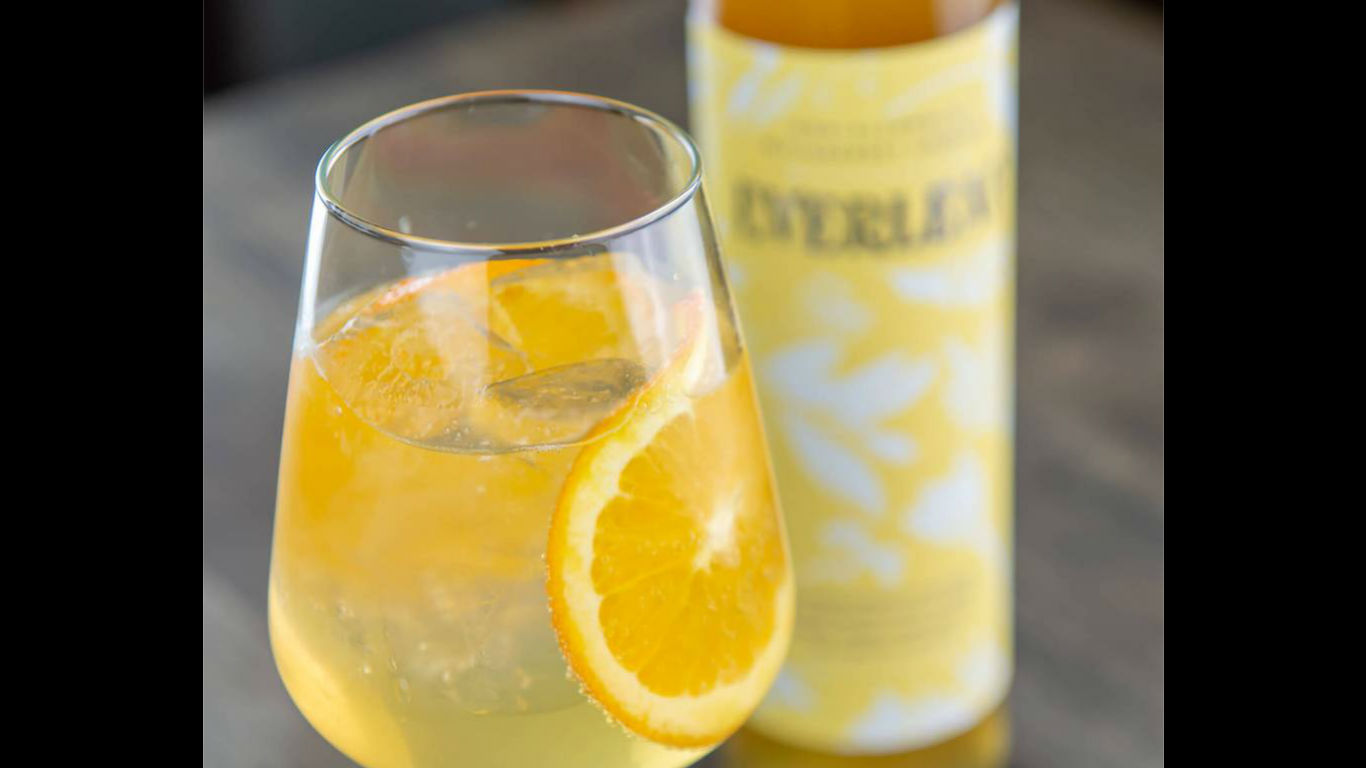
Non-alcoholic spirits
Millennials tend to drink less than they used to, over health concerns, a preference for cannabis, or interest in the “sober curious” movement (see above). “Mocktails” are ubiquitous these days, with good selections offered even at high-end restaurants and trendy bars. But in the past few years, big liquor companies like Pernod Ricard and Diageo, as well as smaller independent operations, have been producing bottled spirits containing little or no alcohol. These contain botanicals and other ingredients meant to suggest some of the same flavors found in actual liquors. Among them are Everleaf, an apéritif made with 18 different plants; Slange Var, a Scottish drink made with honey, lime, and ginger; and Celtic Soul, described by its maker as “a non-alcoholic blend of carefully distilled dark spirits.” “We are what veggie burgers are to beef, what almond milk is to dairy,” Marcus Sakey, co-founder of another non-alcoholic spirits brand, Ritual, told the Chicago Tribune.
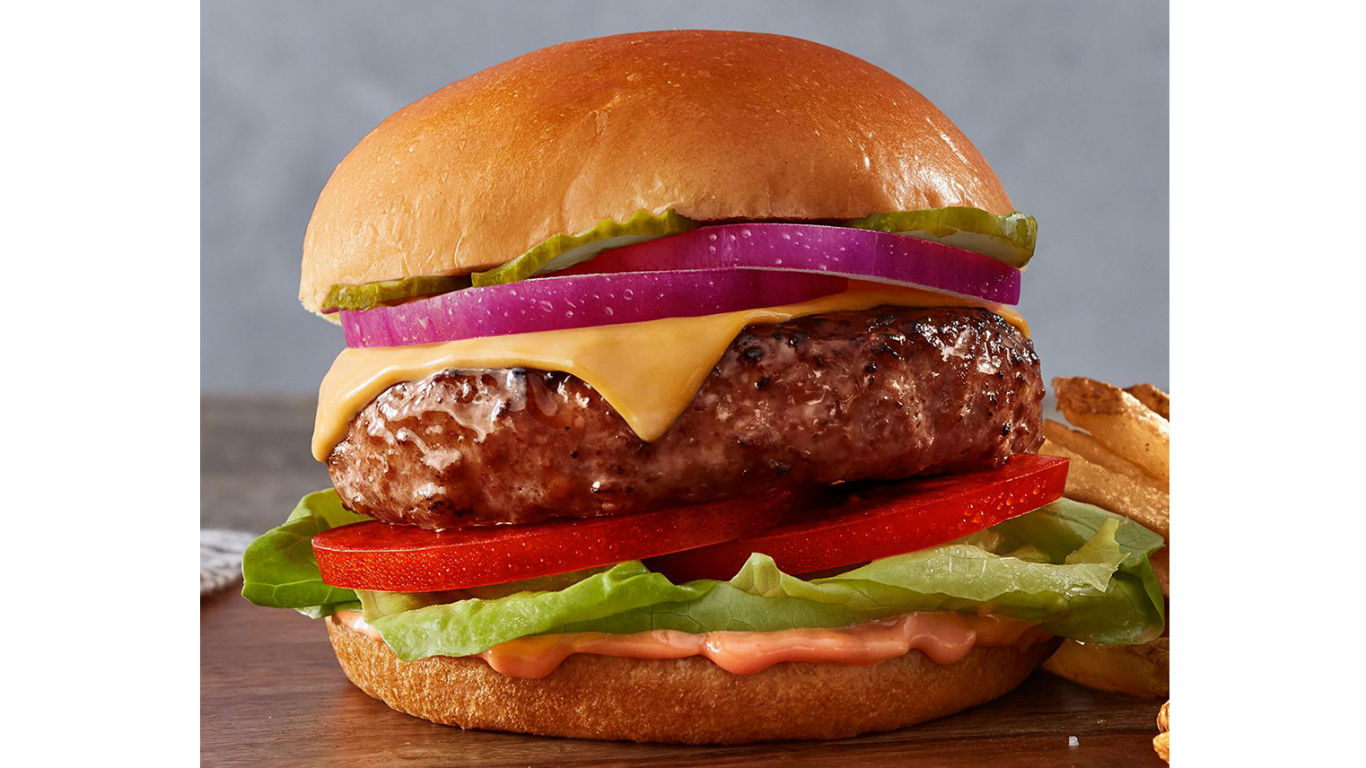
Plant-based meat
Modern-style veggie burgers were invented by London restaurateur Gregory Sams in 1982, and ever since then, vegetable patties have been a staple of supermarket freezer cases and vegan-friendly restaurants. About a decade ago, though, the game changed with the founding of two different California companies — Beyond Meat and Impossible Foods — that developed new products whose flavor and texture approximated those of actual ground beef. Today, an ever-increasing number of restaurant chains have been adding products made by these firms and smaller competitors to their menus — among them Burger King, Carl’s Jr., White Castle, Subway, Dunkin’, Dave & Buster’s, The Cheesecake Factory, Hard Rock Cafe, and T.G.I. Friday’s. The Impossible Burger is now sold in more than 17,000 restaurants, and appeared in supermarkets in September. Beyond Meat, meanwhile, claims to be in “over 58,000 grocery stores, restaurants, hotels, universities and beyond.”
[in-text-ad-2]

iPad menus and wine lists
The restaurant industry is already using technology in many ways, with self-service ordering kiosks, handheld payment terminals, computerized cooking equipment, and other innovations becoming commonplace. Since the early 2010s, diners have also been confronted increasingly with digital menus (using software from companies like MenuPad and eMenu) and wine lists (Uncorkd and Wine List, among others). These allow restaurants to provide their customers with photos of finished dishes and background information on virtually any food and drink they offer — and they can be updated instantly when specials are added or wines run out.

Ghost restaurants
Along with the rise of food ordering apps (see below) has come the proliferation of so-called ghost restaurants — also known as cloud kitchens. These aren’t actual operating eating places, but rather kitchens (or portions of kitchens) devoted exclusively to producing food ordered for delivery online. Sometimes they operate out of full-service restaurants, using underutilized space or personnel, and sometimes they’re set up as freestanding facilities — but wherever they function, they’ve been called the hottest trend in food service today.
[in-text-ad]
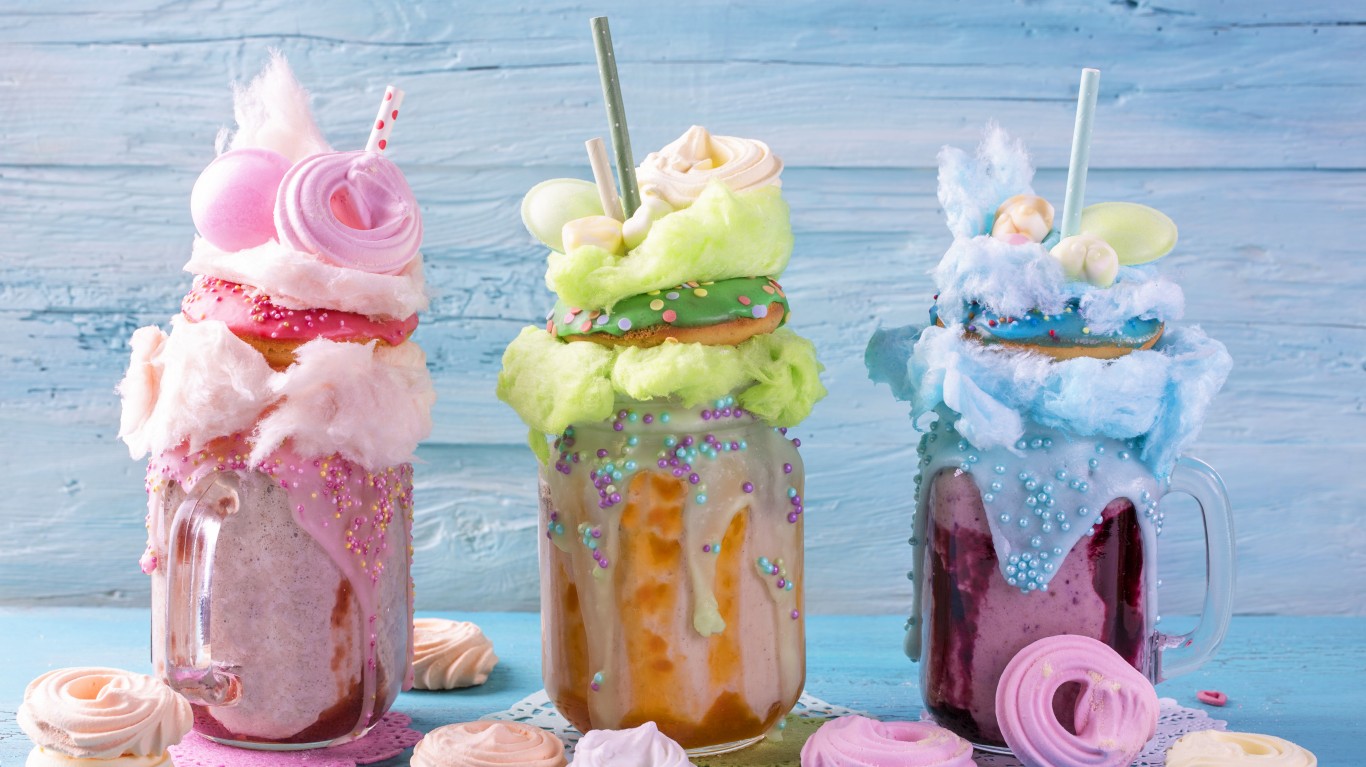
Milkshakes with crazy toppings
First it was crazy Bloody Marys, with that traditional brunch cocktail garnished with everything from hamburgers and fried chicken to fish sandwiches and lobster claws. Now the over-the-top accoutrement fad has gravitated to the dessert menu. According to the iconic milkshake-machine-maker Hamilton Beach, the trend apparently started in Australia in 2015, where the concoctions were dubbed Freakshakes. New York City’s Black Tap ran with the idea the following year, piling various combinations of cotton candy, lollipops, pretzels, M&Ms, marshmallows, candy canes, caramel apples, and other confections atop its shakes. The trend has spread nationwide and shows no sign of abating.
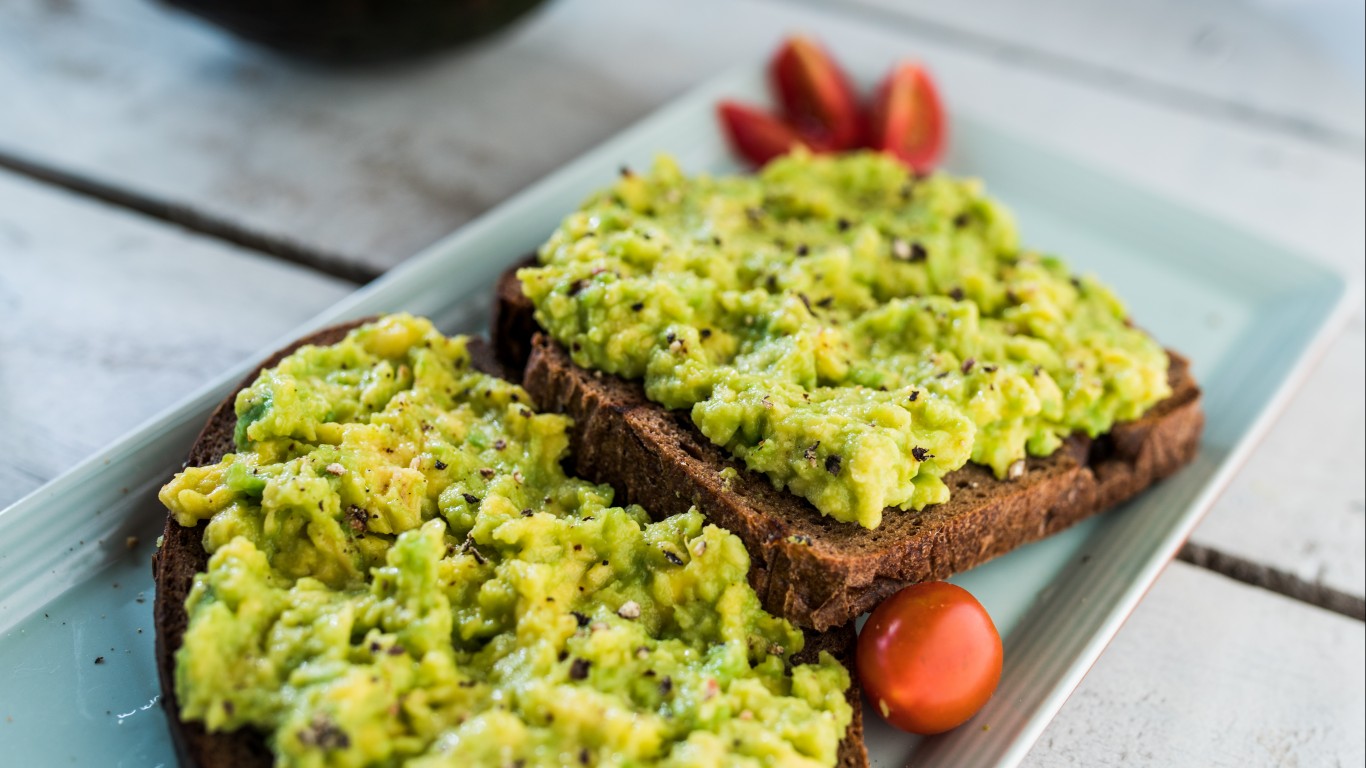
Artisanal toasts
The idea of mashing avocado on toast is said to have been conceived at a restaurant called Bills in Sydney, Australia in 1993, but avocado toast didn’t become a full-fledged U.S. millennial cliché until 2013, when Gwyneth Paltrow included a recipe for it in her cookbook “It’s All Good.” Avocados aside, the artisanal toast trend in America was probably really kicked off a year earlier, after a young L.A. chef named Jessica Koslow put ricotta toast with homemade jam on the menu at her restaurant Sqirl. Today, besides avocado and ricotta, toast might be topped with bananas, nut butters, tomatoes, beans, radishes — almost anything you can think of. When artisanal toast stops being toast and becomes an open-face sandwich isn’t clear.
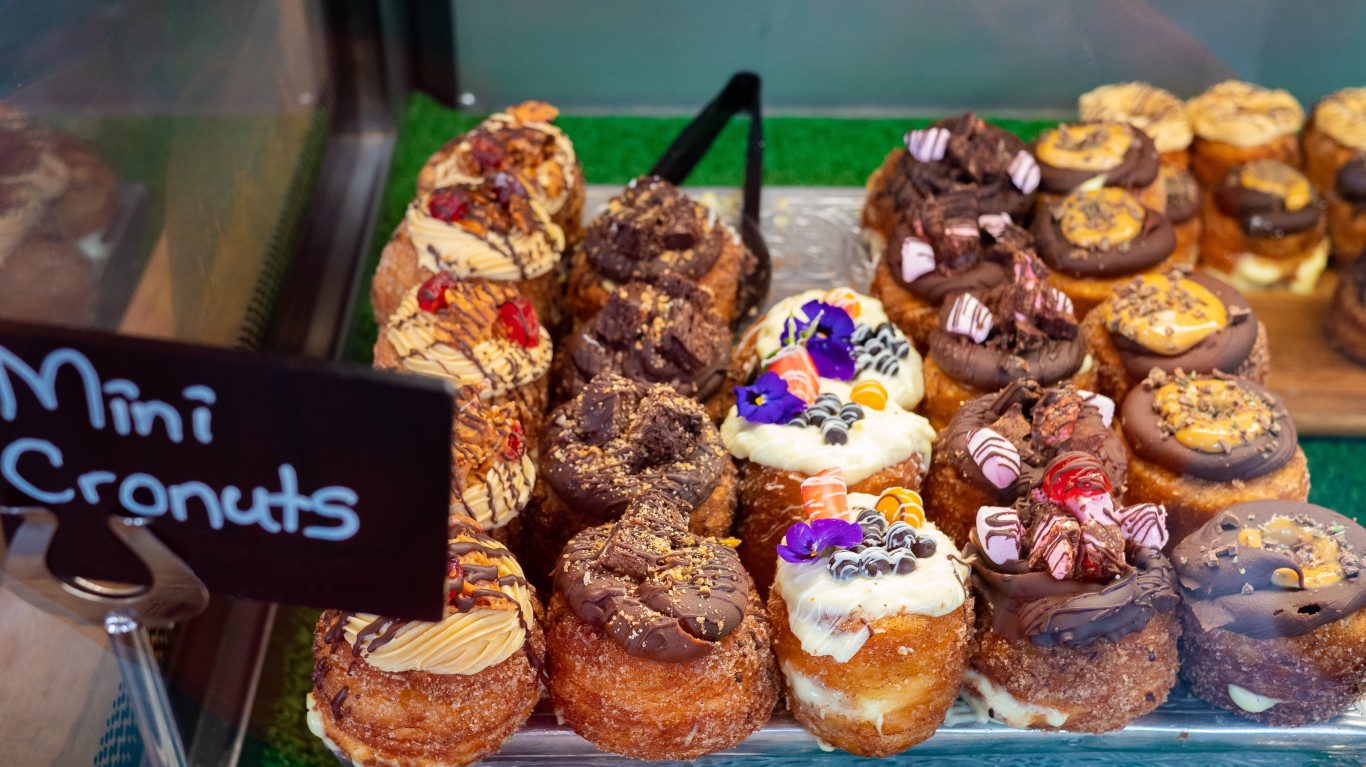
Cronuts and other pastry hybrids
In 2013, French-born New York City pastry chef Dominique Ansel had the bright idea of making a doughnut out of flaky croissant dough, dubbing it the cronut. After a review on Grub Street, his bakery was thronged — and it remains so to this day. The cronut has been copied all over America, and has inspired such other mashups as Cruffins (croissant-muffins), Bonuts (biscuit-doughnuts), and the Cherpumple (three kinds of pie layered inside three kinds of cake).
[in-text-ad-2]
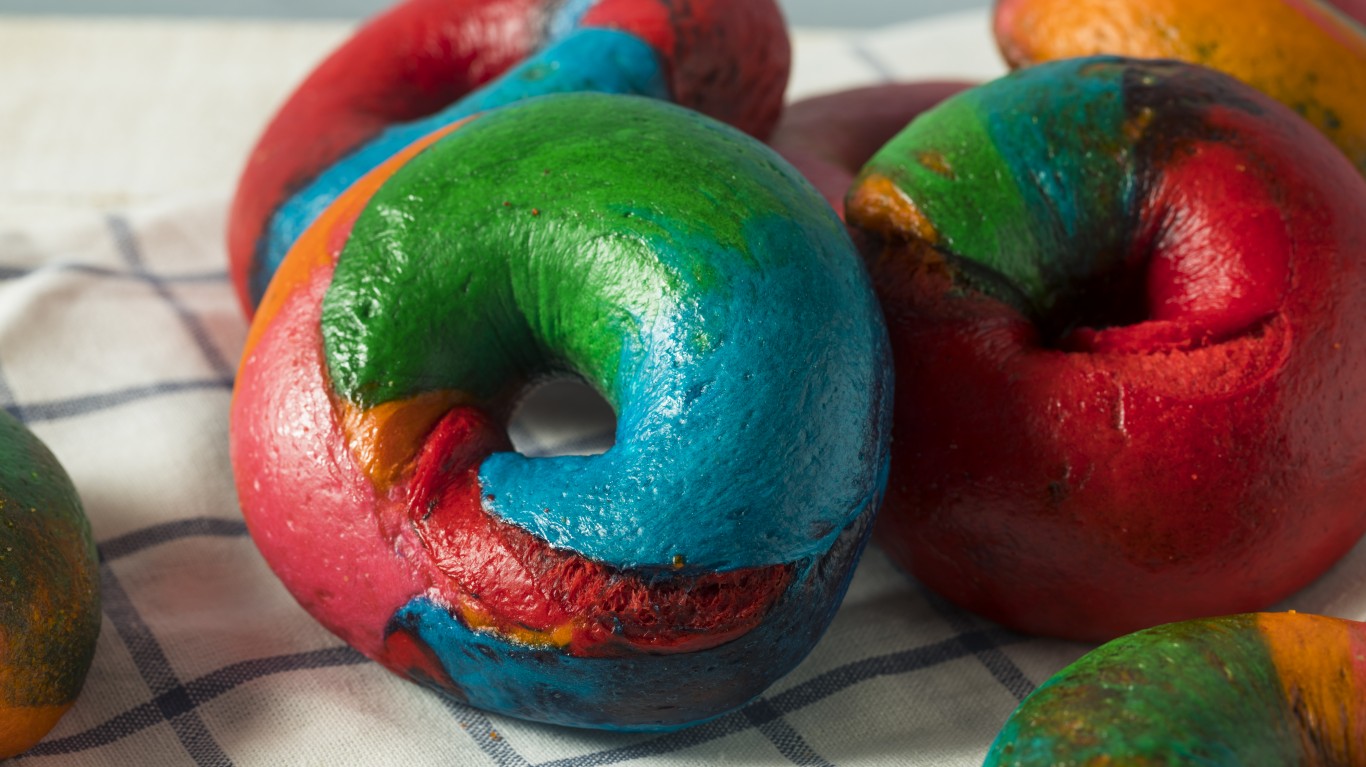
Rainbow food
When nutritionists advise people to “eat the rainbow,” this isn’t what they have in mind. (The phrase is just advice to eat a wide range of fruits and vegetables.) Rainbow food in the trendy sense consists of baked goods and other items striped or layered with many colors — what Eater described as “foods that look like they belong in a Lisa Frank-designed universe populated by unicorns.” Rainbow bagels may have gotten the trend started. “Bagel artist” Scot Rossillo of the Bagel Shop in Brooklyn says he invented these more than 20 years ago — but it was only in the mid-2010s that they started taking over social media. Now there’s rainbow cake, rainbow doughnuts, rainbow pasta, rainbow burger buns, rainbow popcorn balls, rainbow grilled cheese, and much more.

Gluten-free everything
An estimated 1% of the world’s population has celiac disease, a serious autoimmune condition stimulated by gluten, a protein found in wheat and other grains. Many other people claim to be allergic to gluten without being celiac. (Some studies suggest that gluten isn’t really the source of their ailments.) Still others go gluten-free because they imagine that it will improve their health in various ways. There’s little evidence that it does, but nonetheless, “gluten-free” became a full-fledged fad in the 2010s, with the number of people avoiding gluten tripling between 2009 and 2017. Today it is possible to buy not only a full range of gluten-free breads and pastries but also gluten-free cereal, mac ‘n’ cheese, pizza, pancake mix, pasta, and much more.
[in-text-ad]
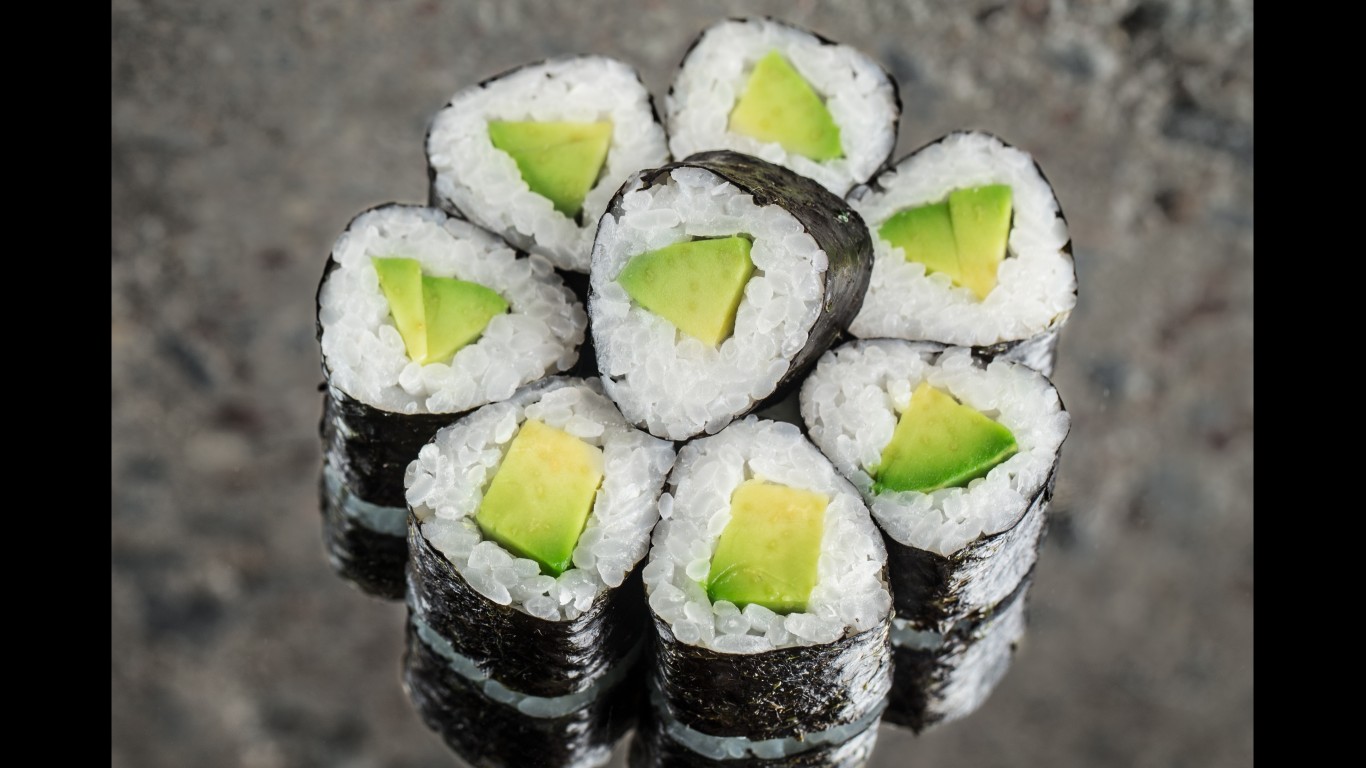
Avocado everything
Avocado toast (see above) is everywhere these days, and guacamole has never gone out of fashion, but the buttery Mexican-born fruit, also known as the alligator pear, is now showing up in all kinds of places. It’s found increasingly in sushi rolls. It makes a good substitute for mayonnaise in tuna or chicken salad or as a sandwich spread. It can take the place of sour cream in baked potatoes, be turned into ice cream, enhance chickpeas (see below) in hummus, enrich smoothies… You can even cut avocados into batons and deep-fry them just like French fries.
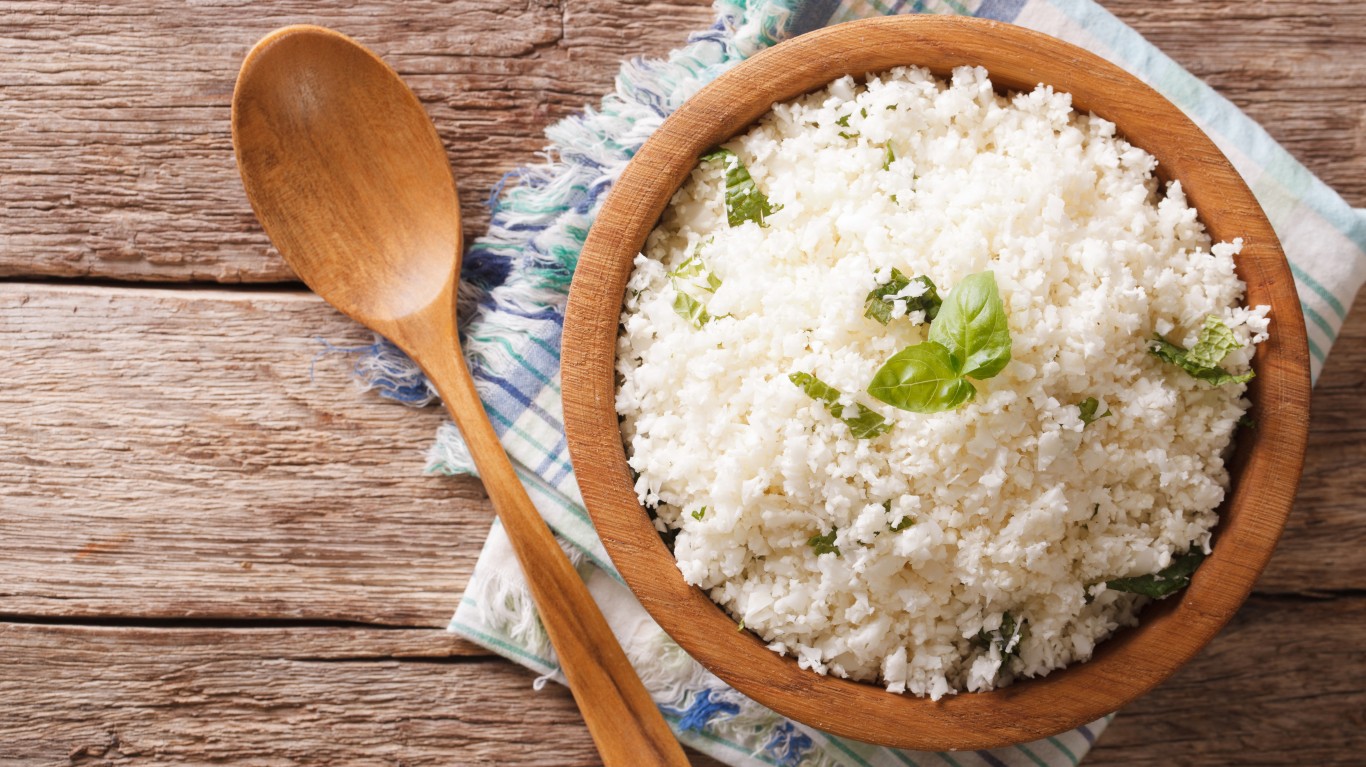
Cauliflower everything
For most of its existence, cauliflower — a relative of broccoli, Brussels sprouts, kale, and other members of the genus Brassica — was a rather boring vegetable, typically boiled and separated into florets, maybe napped in a cheese sauce if the diner was lucky. Today it’s a star on restaurant menus everywhere, in a myriad of forms. There’s whole roasted cauliflower, popularized by Israeli chef Eyal Shani about 15 years ago and introduced to American menus in 2015; there’s “rice” and “tabbouleh” made from finely shredded florets; thick slabs of cauliflower are roasted into “steaks;” there’s even pizza crust made from puréed cooked cauliflower, cheese, and eggs.
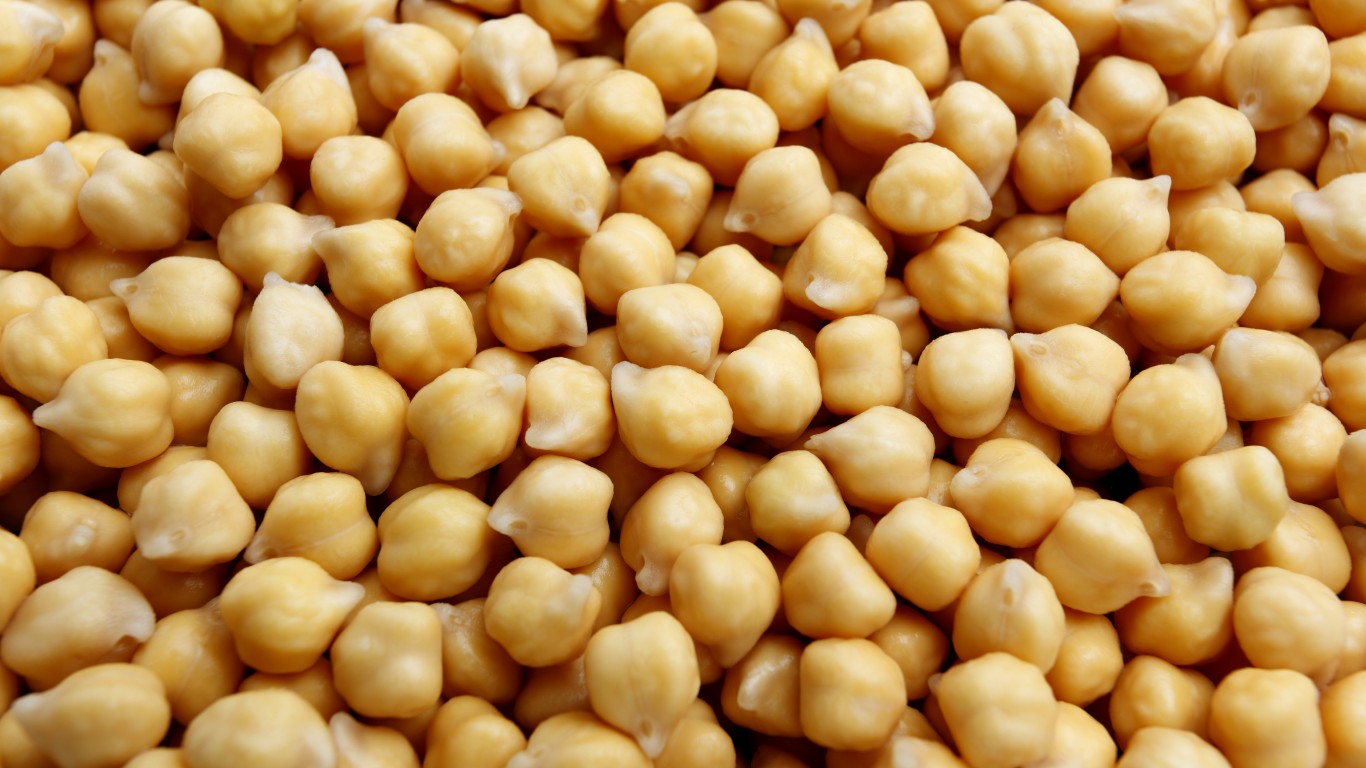
Chickpeas
Chickpeas, also known as garbanzos, are a staple vegetable found in cuisines everywhere from Spain to Israel to India. But they’ve become so much more than just vegetables for stews or salads. Chickpea-based hummus is everywhere, plain and in numerous flavors. Then there’s falafel, a sandwich-shop standard today. But chickpeas also yield milk (see below), flour (for pasta and other purposes), a butter substitute, and even ice cream. As a story headline in Vogue asked late last year: “Are Chickpeas the New Chic Peas?” Apparently so.
[in-text-ad-2]
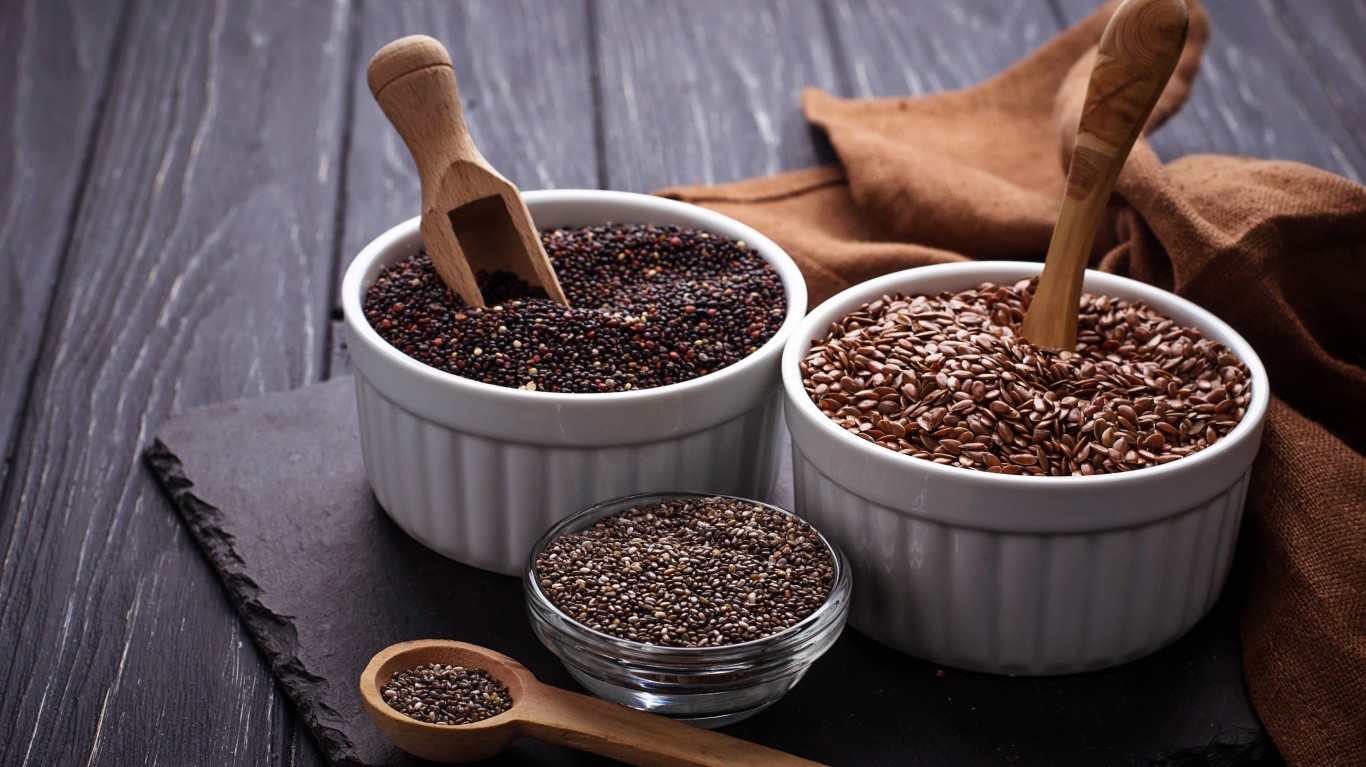
Chia seeds and flaxseeds in everything
Chia seeds are a so-called “superfood” that come from a plant called Salvia hispanica, related to mint (and yes, that’s the same plant that covers terracotta chia pets with their grassy green coat). Once an important food for the Aztecs and Mayans, they are hailed for their health benefits today and end up in smoothies, puddings, breakfast cereals, energy bars, açaí bowls, and more. Google searches for chia seeds have increased more than 800% in the past decade, and the global market for them is expected to reach almost $3 billion by 2023, with North America being the biggest consumer. The seeds of the flax plant — whose fibrous stems are also the source of linen — are another superfood with high nutritional value, and have also become very popular over the past decade. The seeds are often sprinkled on cereals or over fruit, while ground flaxseeds can be mixed into baked goods, soups, salads, pasta dishes, and more, or even used in place of bread crumbs. The global market for the seeds is expected to grow 11.86% over the next five years, with North America again using them the most.
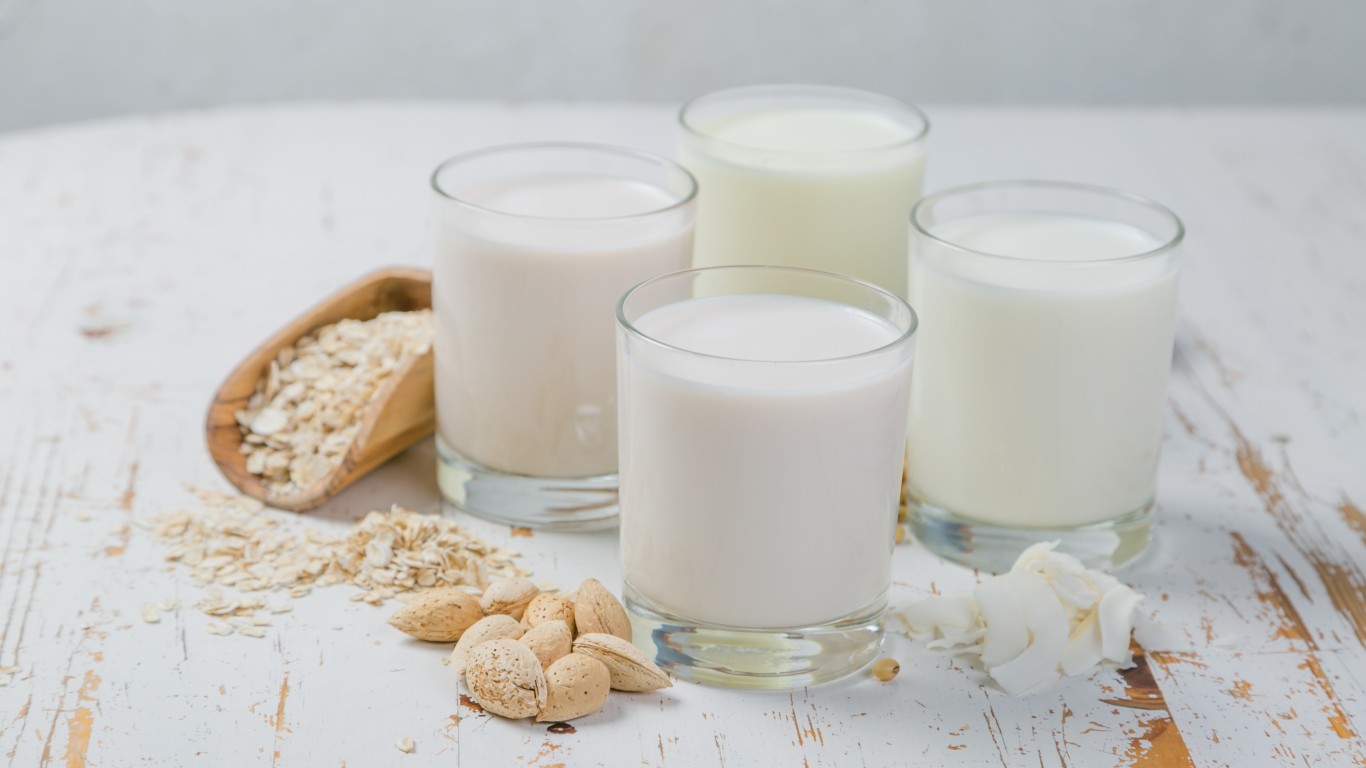
Alternative milks
Milk made from soy or almonds has been around for years in America (Starbucks could hardly function without it), but now there’s mock-dairy made from all kinds of other things, too — flax seeds (see above), cashews, hazelnuts, walnuts, macadamias, oats, peas, rice, peanuts, coconut, chickpeas (see above), hemp, and more. To what extent these taste like cow’s milk varies, but they’ll all turn your coffee white. The dairy industry, meanwhile, is pressuring the FDA to restrict the use of the term “milk” for anything that doesn’t come from animals.
[in-text-ad]
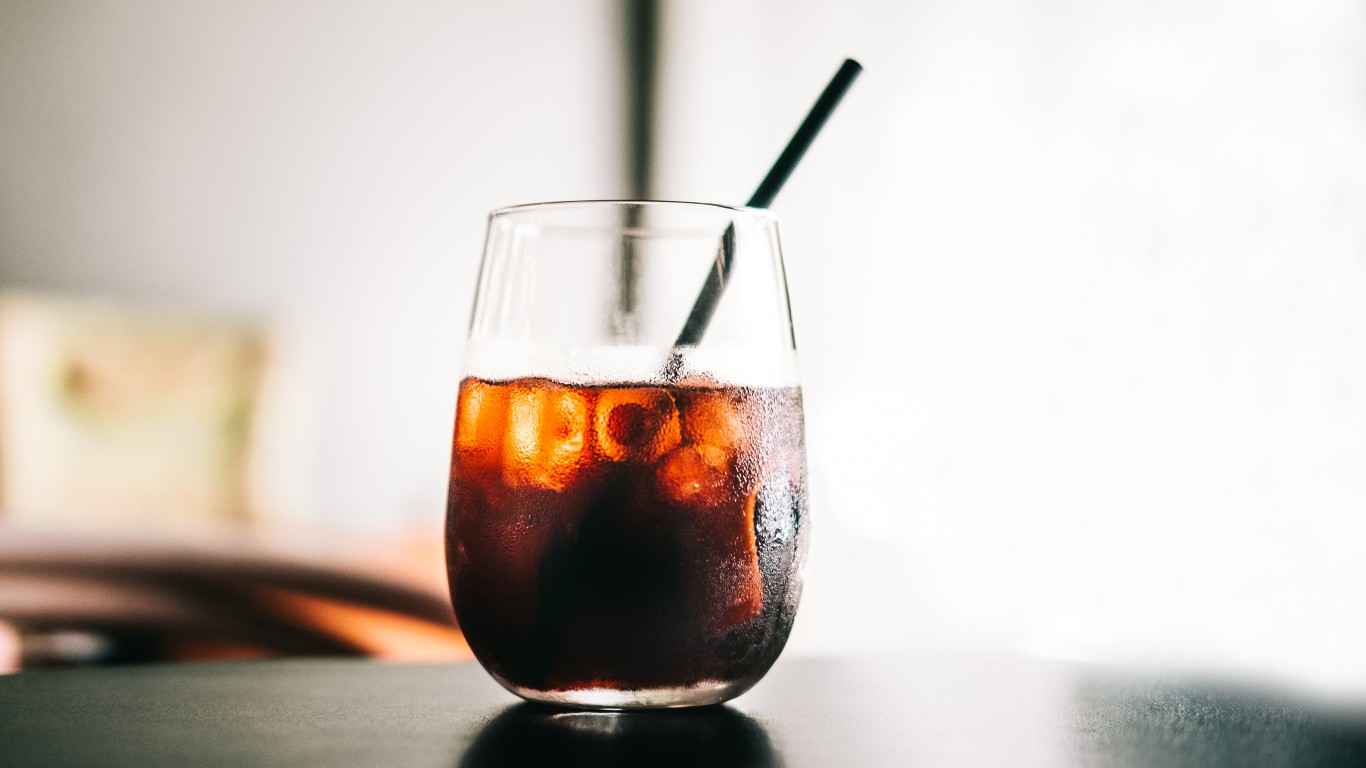
Cold brew coffee
The origins of cold brew coffee may be traced to Kyoto, Japan, way back in the 1600s. The Japanese method of making it involves letting water drip, drop by drop, through the grounds over a long period of time. The more common method today is through immersion — letting coffee grounds steep in water for anything from six to 24 hours to extract their flavor. It isn’t clear when cold-brewing first came to America, but as with so many other coffee trends, it was Starbucks that popularized it, introducing it in 2015.
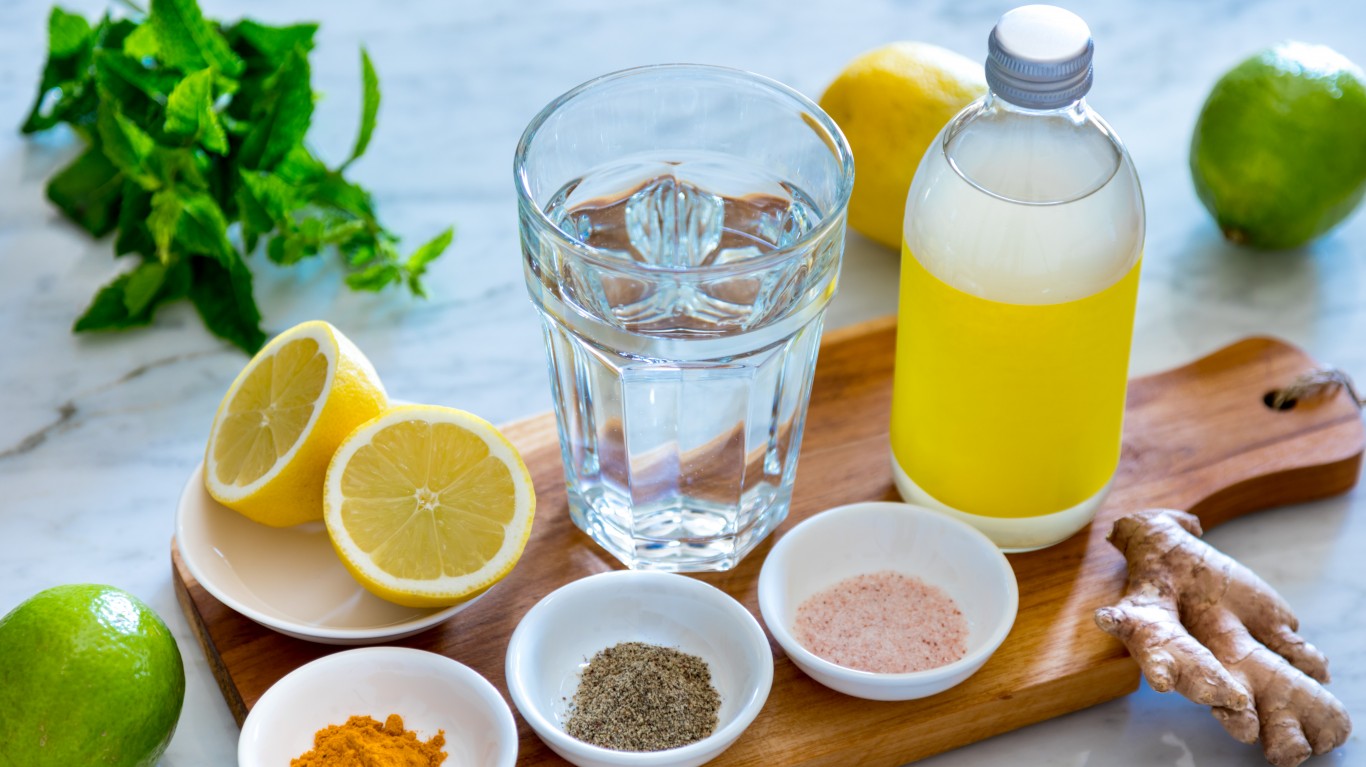
Enhanced water
Bottled water (both still and sparkling) flavored with citrus and other fruits and herbs has been around for more than 20 years, but it has really flooded the market, as it were, in this decade. One survey predicts that the market for these beverages will see a compound annual growth rate of 9.5% between 2017 and 2023. Another variety of enhanced H20 is alkaline water, treated to have a particularly high pH. It is said to have many health benefits, though scientists debunk these claims. Then there’s turmeric water, infused with that vivid yellow-orange spice, whose active ingredient, curcumin, is said to be useful for treating diabetes, glaucoma, infertility, and other ailments. The jury is out.
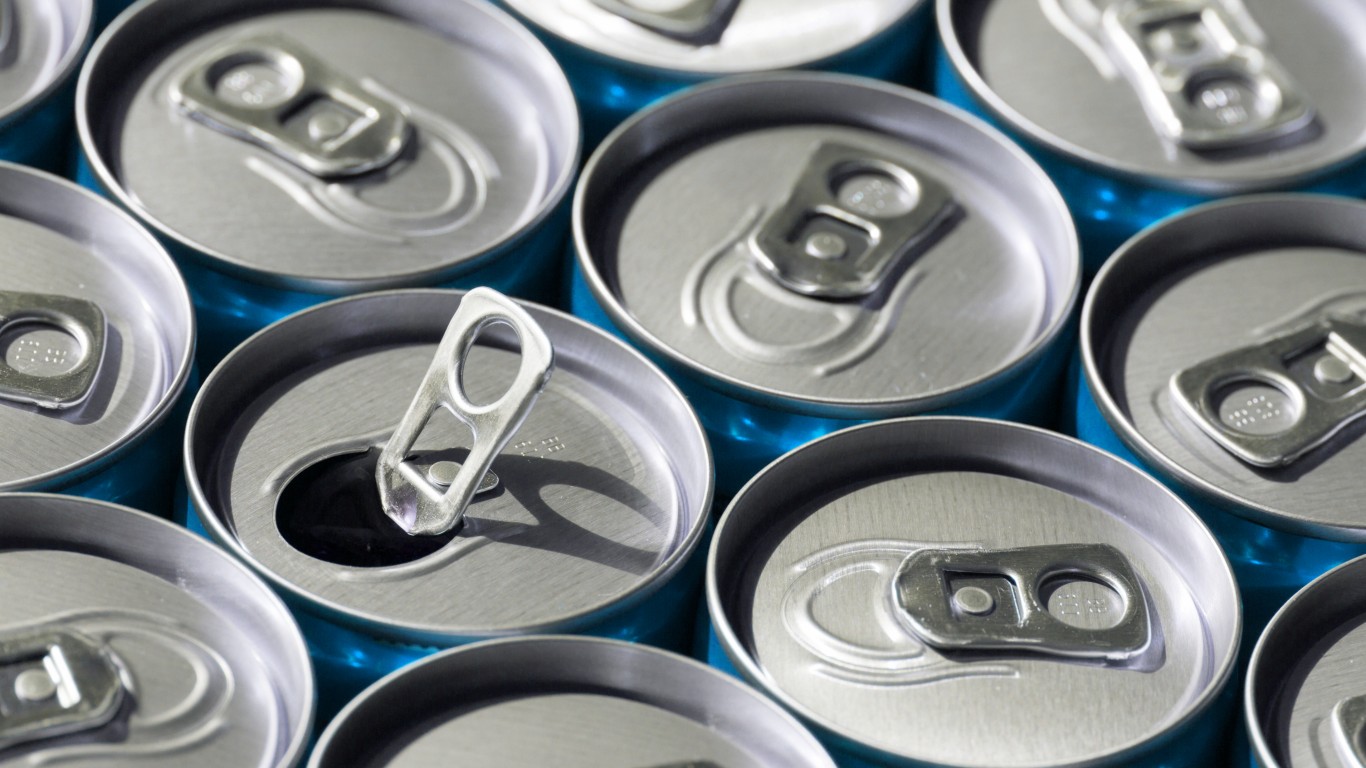
Hard seltzer
A Connecticut beer executive invented modern-day hard seltzer — which is basically spiked, flavored soda water (typically with an ABV of 4% to 6%, about the same as light beer) — in 2012, marketing his brand as SpikedSeltzer. In 2016, he sold it to Anheuser-Busch InBev, the world’s largest brewer, and they took it national. The same year, another brand, White Claw (owned by the same company that owns Mike’s Hard Lemonade) launched — and soon became the category leader, with a 50% market share. Hard seltzer became the drink of the summer this year, converting wine, beer, and vodka drinkers and recording a 164.3% sales increase in July alone (223% for White Claw specifically).
[in-text-ad-2]

Kombucha
Kombucha is fermented tea and is believed to have numerous health benefits. Said to have been invented in northeastern China around 220 B.C., it reached Europe in the early 20th century, and hit American shores in the 1990s. It ran into trouble at the beginning of this decade due to its (very low) alcohol content, but quickly rebounded, showing a 28% sales increase between 2010 and 2011. PepsiCo showed that it has faith in kombucha’s potential by purchasing a bottled brand, KeVita, in 2016, and it is estimated that the beverage will be racking up $1.8 billion in annual sales by next year.

Rosé
Rosé used to be dismissed as an uninteresting wine category, a simple summer quaff or an easy choice when you couldn’t decide between red or white. Today, it’s hot. Though it’s made in virtually every wine-producing country, French rosé seems to be the category leader. It started gaining popularity in the early 2000s, but really took off about four years ago — showing a 33.9% increase in sales in the 52-week period ending in May of this year alone. It “has benefited from its positioning as a gender-neutral beverage, which opens the door to more occasions and consumers, such as brunch,” says IWSR, an alcohol trend-watching site. Both regular and sparkling rosé have maintained double-digit growth since 2014. Part of rosé‘s success can be attributed to the fad for frosé — frozen rosé, either plain or blended into a kind of slushie with various fruits and even vodka added — though that drink’s popularity seemed to peak after the summer of 2018.
[in-text-ad]
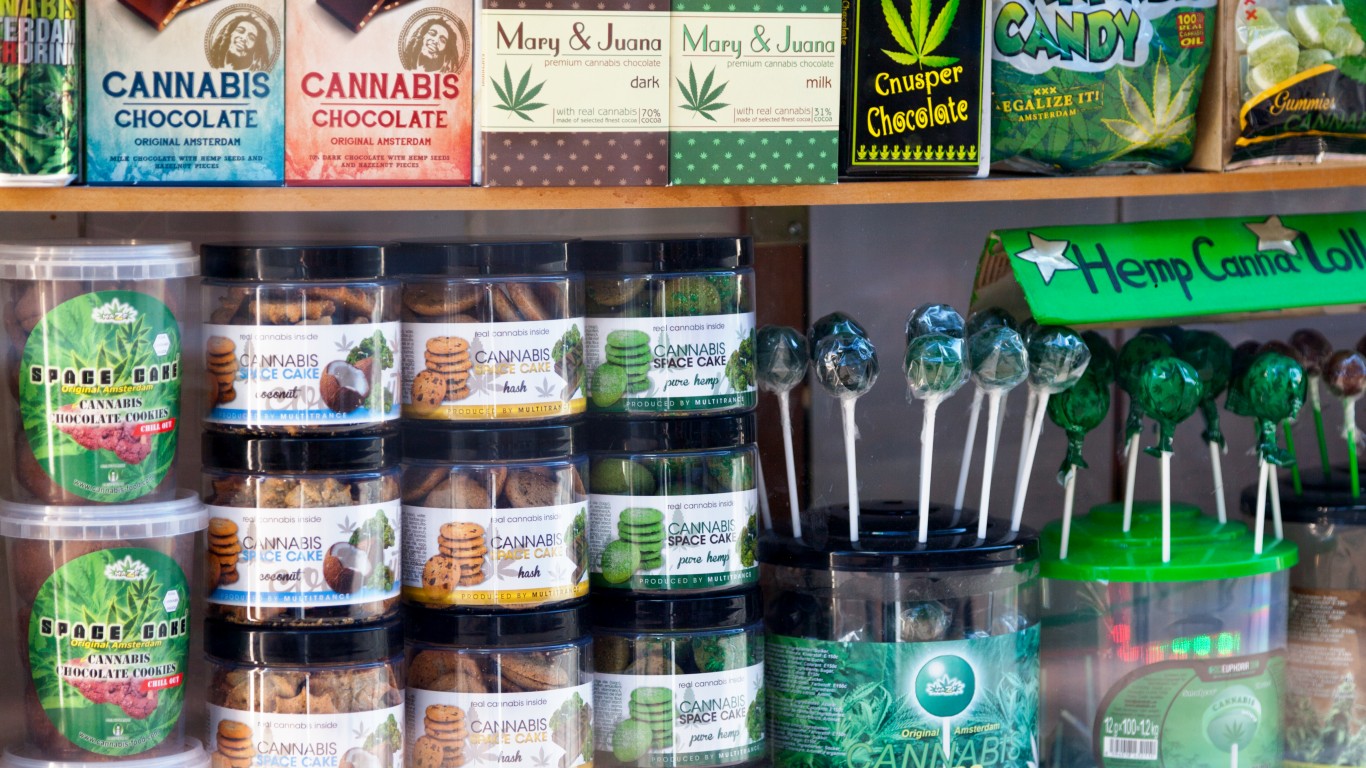
Edibles
Recreational marijuana use is now legal in 11 states (the first of these, Washington, took the step in 2014) and the District of Columbia, and possession of small amounts has been decriminalized in a number of places. There are plenty of options for those who want to enjoy the pleasant effects of the drug but prefer not to smoke, as cannabis now appears in everything from candies and baked goods to vitamins to beverages (including wine). Sales of edibles in the U.S. are projected to reach $21.6 billion by 2021.

CBD foods
Cannabidiol, known for short as CBD, is a non-psychoactive ingredient of cannabis. In other words, it won’t get you high — but it is said to have a myriad of health benefits, relieving anxiety, insomnia, various aches and pains, and more. It started to get really big only last year — perhaps, mused the New York Times, when Mandy Moore announced that she used it to relieve the pain of wearing high heels, or when Willie Nelson introduced a line of CBD-infused coffee beans, or when Dr. Sanjay Gupta touted it on “The Dr. Oz Show.” While its use is controlled in some places — New York City, for instance, bans its use by restaurants and bars — CBD is now added not just to the Red-Headed Stranger’s coffee but to bottled water, cereal, popcorn, honey, matcha, gummies, and cookie dough bites, among many other foods and beverages.
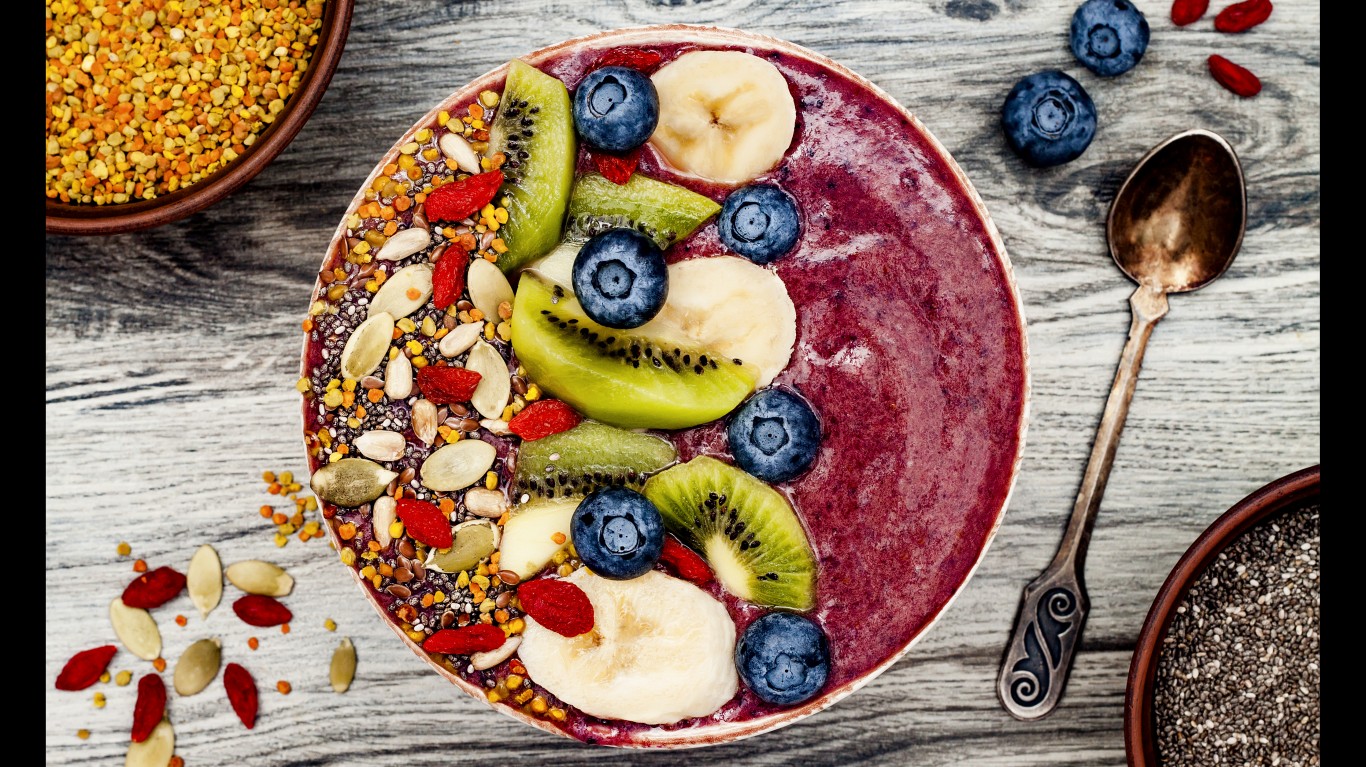
Bowl food
Eating food out of a bowl…what a concept. We’re not talking about soup or chili or cereal — old-school bowl food. What became a full-fledged trend around 2016 was the idea of arranging various foods, usually in colorful contrast, in a bowl, in ways that seemed to not quite be salad form. Hawaii’s poke (see below) was an earlier bowl ingredient, dating from around the 1970s, though it’s not always served in bowls. The more recent iteration has two main variations: the so-called Buddha bowl, a combination of grains — quinoa is a quintessential bowl constituent — with an assortment of cooked or raw vegetables; and the açaí bowl, a kind of partial-smoothie combining a purée or powder of that faddish South American fruit with yogurt or milk and various fresh fruits, nuts, etc. A variation is the goji bowl, with the berry of that name, long used in traditional Chinese medicine, added to bowls in place of or sometimes in addition to açaí berries. Bowls are so popular that they were part of the menu at Prince Harry and Meghan Markle’s 2018 wedding — though in that case they were filled with things like pea and mint risotto with pea shoots, truffle oil, and parmesan crisps.
[in-text-ad-2]
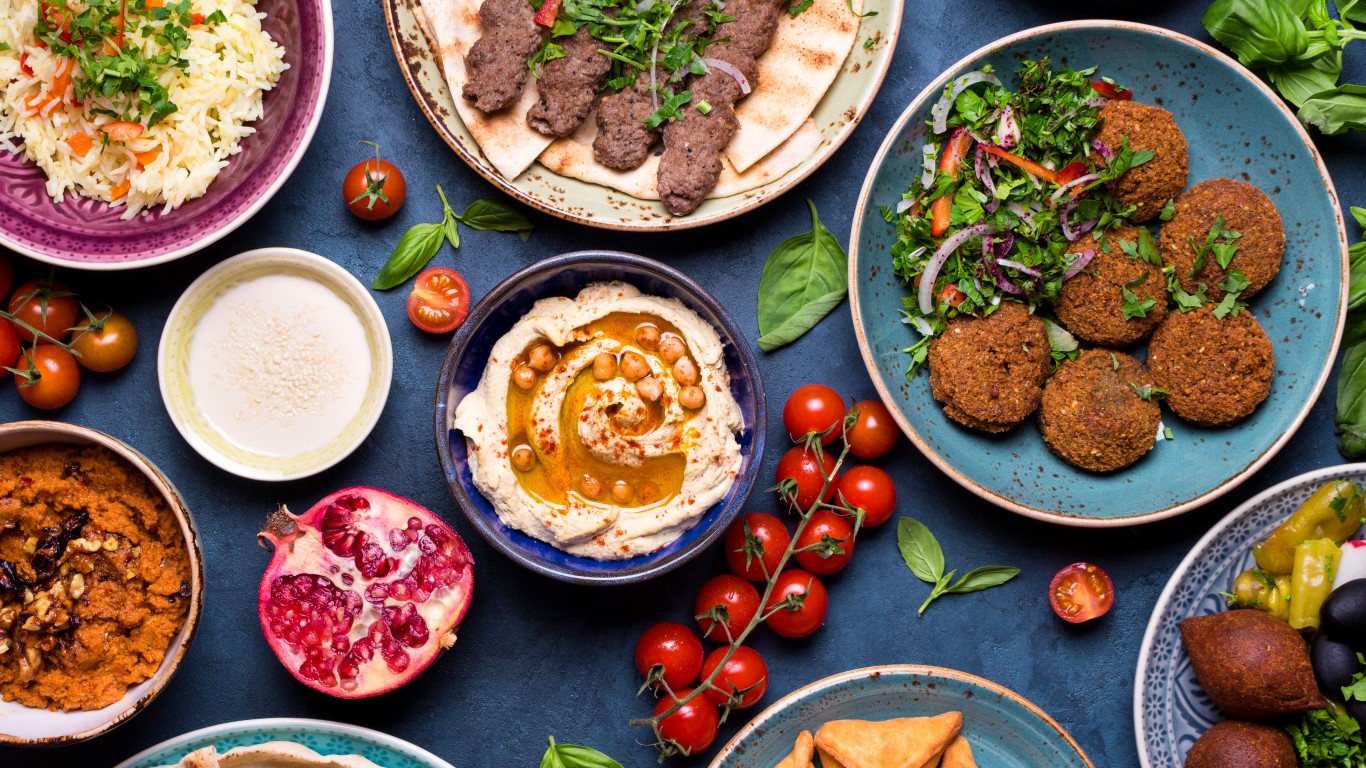
Middle Eastern food
Whole Foods predicted in 2017 that Middle Eastern cuisine — largely vegetable-focused and quintessentially Mediterranean — would be one of the top food trends of 2018, citing hummus, pita, and falafel as entry points. Though the trend started some years earlier, they were clearly right. The spice mixture called za’atar is appearing on more restaurant menus and grocery store shelves, while tahini (sesame paste) is going mainstream in smoothies, cocktails, baked goods, and more. Such chains as Cava, Roti, Taïm, Hummus & Pita Co., and Zöe’s Kitchen — all serving Middle Eastern-style dishes to a greater or lesser extent — are proliferating. Upscale Middle Eastern restaurants like Bavel in Los Angeles, Nur and Ilili in New York City, Zahav in Philadelphia, and Saba in New Orleans are thriving.

Pumpkin spice mania
Starbucks got the craze started when it rolled out its Pumpkin Spice Latte nationally in 2004, and other coffee and fast food chains, including 7-Eleven, Dunkin’ Donuts, McDonald’s, and Tim Hortons, were soon brewing versions of their own. It has only been in the past decade, though, that hunger for things pumpkin-spiced (which generally means flavored with cinnamon, ginger, nutmeg, allspice, and sometimes cloves) has gone viral. Trader Joe’s alone sells about 60 products in the genre, and it is now possible to indulge your pumpkin-spice craving with everything from almonds to cheese to a martini.
[in-text-ad]
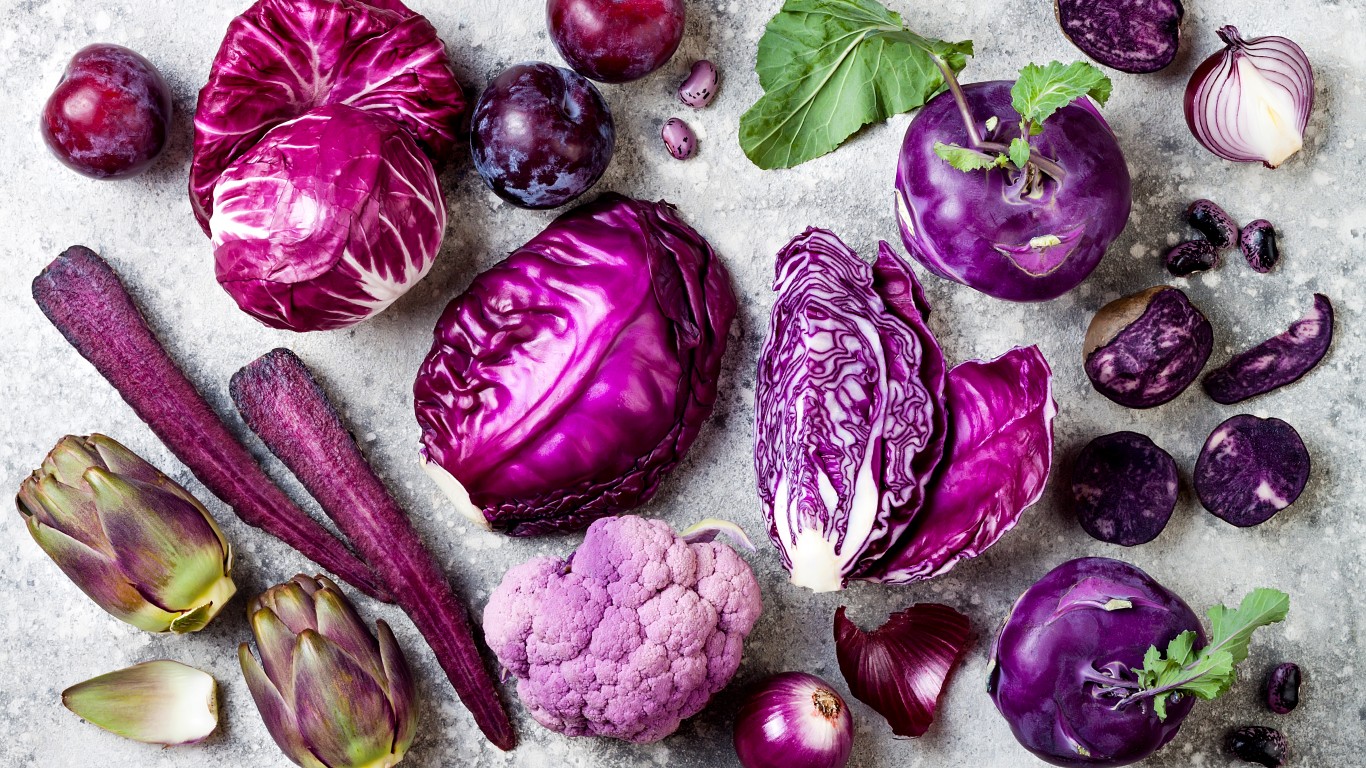
Purple vegetables
The color purple in fruits and vegetables is an indicator of a high content of phytonutrients – compounds with antioxidant and anti-inflammatory properties, among other health benefits. That’s apparently the reason behind the increased popularity of things like purple carrots, sweet potatoes, and yams in supermarkets. There are plenty of examples of items purple (or bluish-purple) in whole or in part — turnips, beets, eggplant, kohlrabi, blackberries and blueberries, figs, grapes, and more. “If I could eat only one color per day, it would be purple,” James Joseph, a neuroscientist at Tufts University’s USDA Human Nutrition Research Center On Aging, told the urban gardening website Growtest.
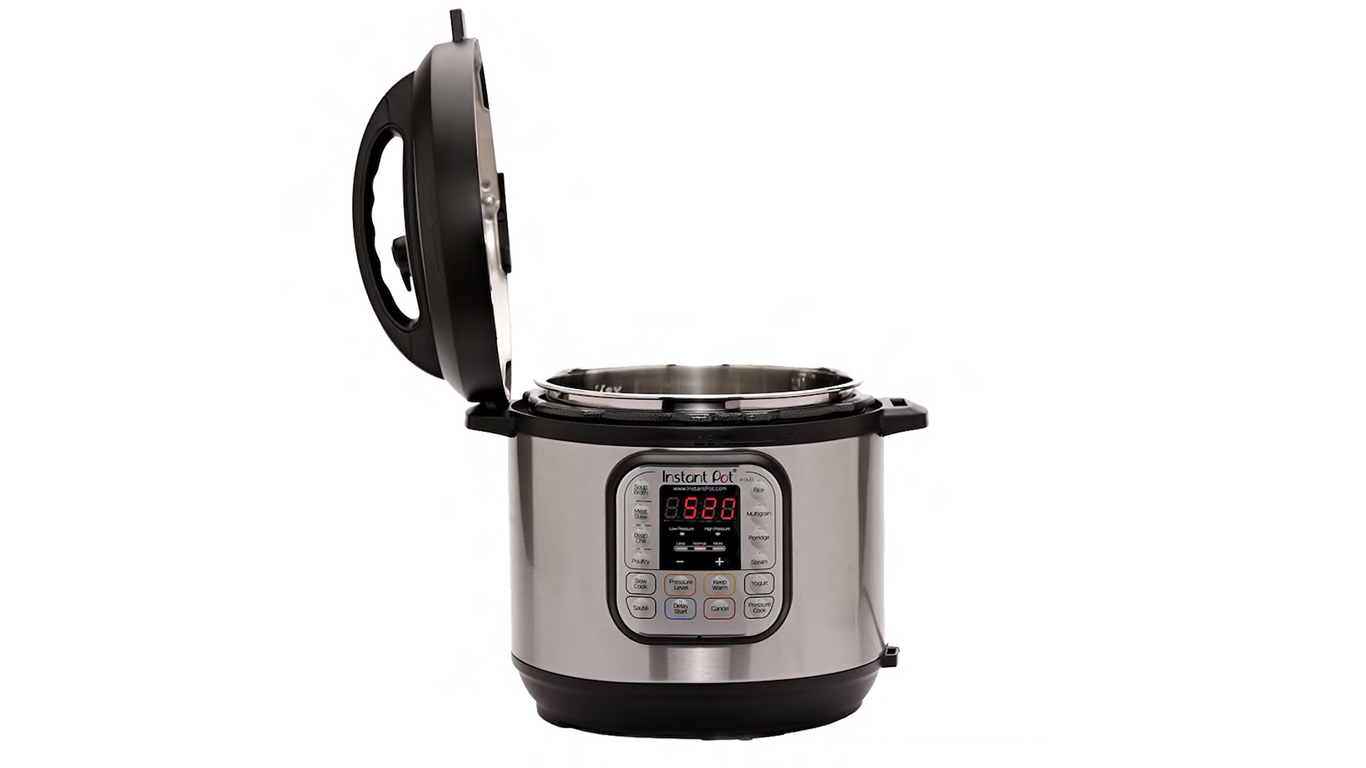
Instant Pot meals
The Crock-Pot and other slow-cookers became popular in the 1970s, but the genre got a reboot after an out-of-work computer scientist turned inventor launched the Instant Pot in late 2010. It basically combines the function of a slow-cooker with that of a pressure-cooker — with the added functions of a rice cooker, steamer, sauté pan, yogurt maker, cake maker, warmer, and sterilizer. Sales grew slowly, but today more than 5.5 million people follow an Instant Pot-related page on Facebook, and the cooker sold 300,000 units on last year’s Amazon Prime Day. New York congresswoman Alexandria Ocasio-Cortez, an outspoken fan of the Instant Pot, asked her 1.2 million Twitter followers for their favorite recipes using the device.
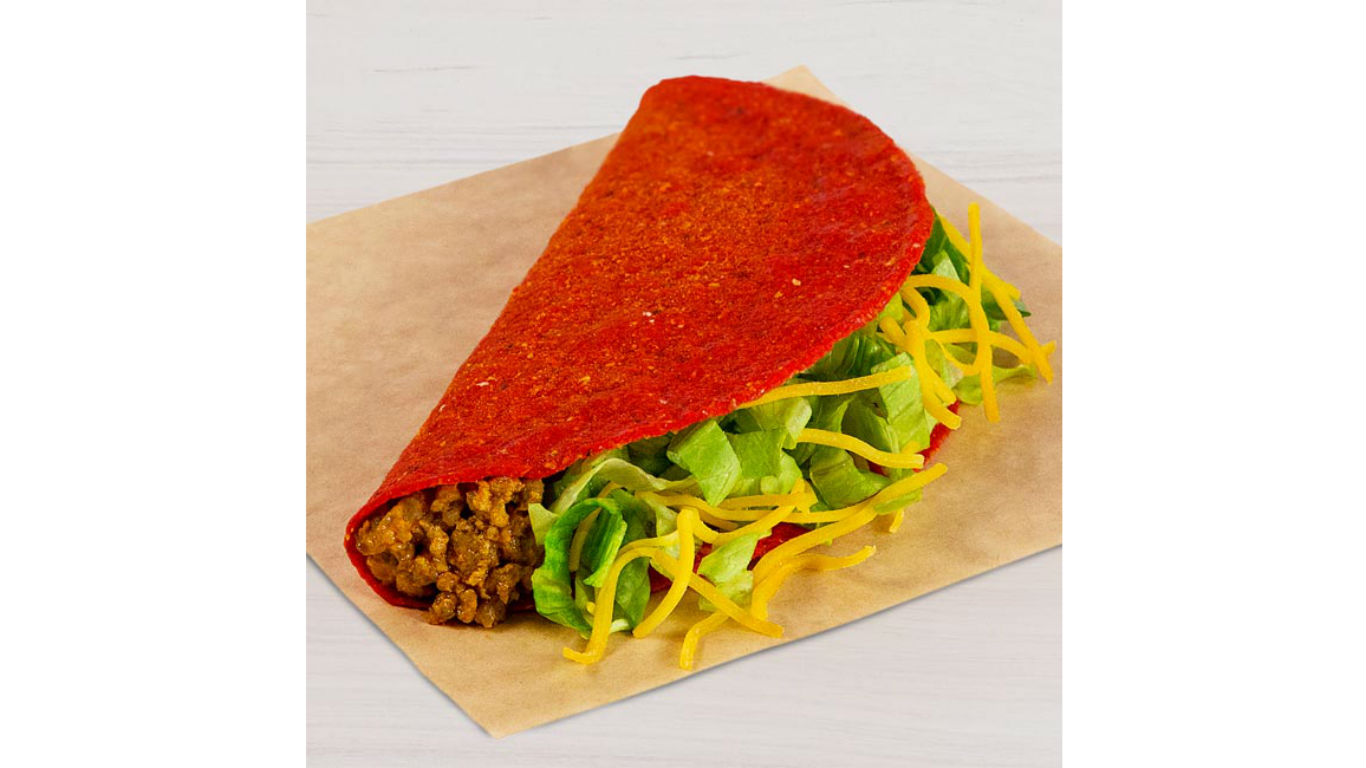
Fast food mashups
People have been making their own fast-food mashups for many years (for instance, combining a Filet-O-Fish, a chicken patty, and a Big Mac into a single sandwich at McDonald’s — sometimes dubbed the McLand, Air, and Sea Sandwich). But these over-the-top combinations really began attracting attention in 2010 with KFC’s notorious Double Down — a bacon and cheese sandwich with two pieces of boneless fried chicken in place of a bun — and in 2012, when Taco Bell introduced its Doritos Locos Taco, basically taco fillings inside a Doritos shell. After that, the game was on, and we’ve seen such questionable innovations as the Denny’s mozzarella-stick grilled cheese sandwich, Pizza Hut’s hot-dog-stuffed-crust pizza, and a stadium offering from Frito-Lay — Cheetos-flavored popcorn mixed with actual Cheetos.
[in-text-ad-2]

Food delivery apps
The first online food order was placed at a Pizza Hut in an unspecified location in 1994. The following year, World Wide Waiter — now Waiter.com — became the first online food delivery service. Seamless was founded in 1999 and GrubHub in 2004, but it wasn’t until the 2010s that the delivery industry really took off. Postmates appeared in 2011. DoorDash (the current industry leader) followed in 2013 and Seamless and GrubHub merged the same year. Uber Eats launched in 2014. There are numerous other smaller operations in the field, both regional and national. More than 38 million people will order meals online this year in America, a 21% increase over 2018. Nine out of 10 people surveyed say that ordering in makes their lives easier, according to a 2016 report.
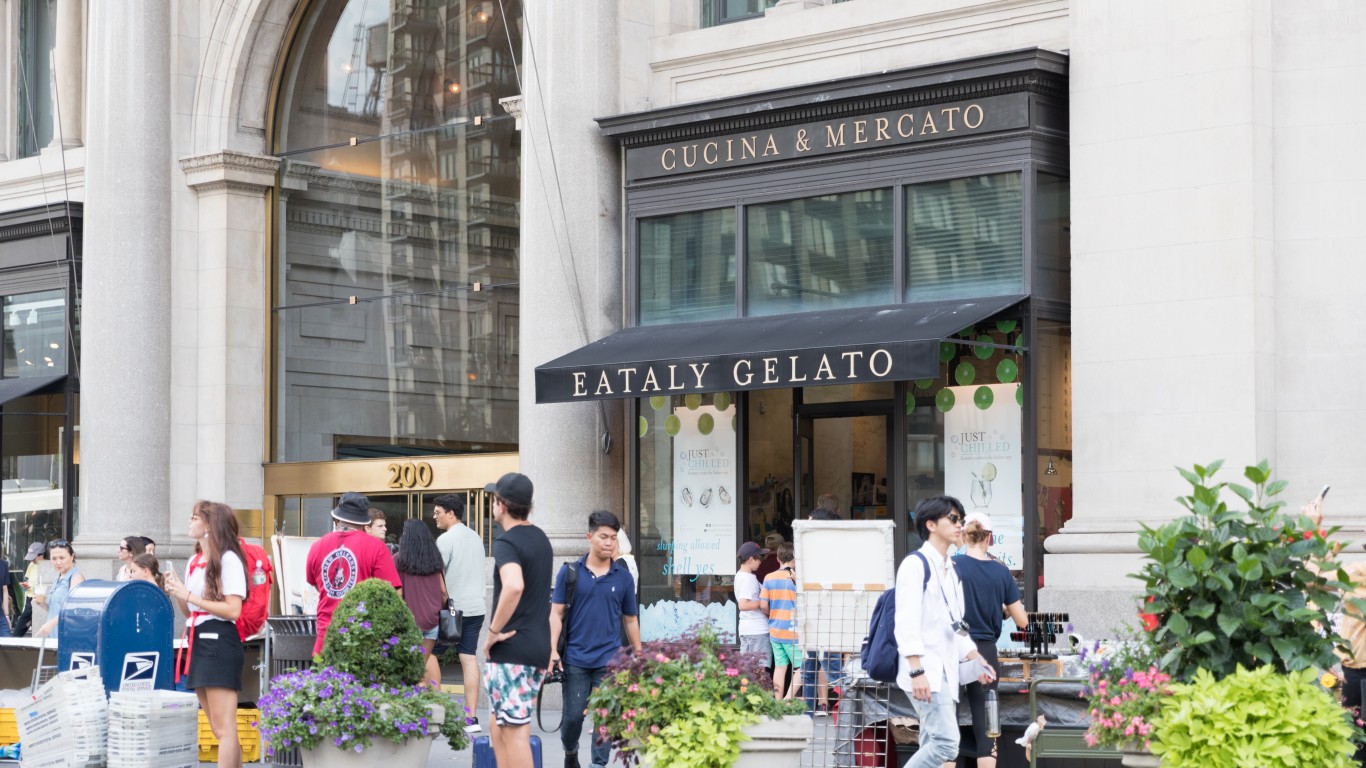
Food halls
The original Eataly, which opened in an abandoned factory in Turin, Italy, in 2007, is considered to be the first modern-day food hall — an aggregation of food stalls or counters and food vendors of various kinds under one roof, but of a higher quality than the typical shopping mall food court. Though there were some scattered examples elsewhere, the opening of an Eataly outpost in New York City in 2010 popularized the idea in America. By the end of this year, there are expected to be at least 200 of these eclectic culinary marketplaces around the country — twice the number there were in 2016.
[in-text-ad]
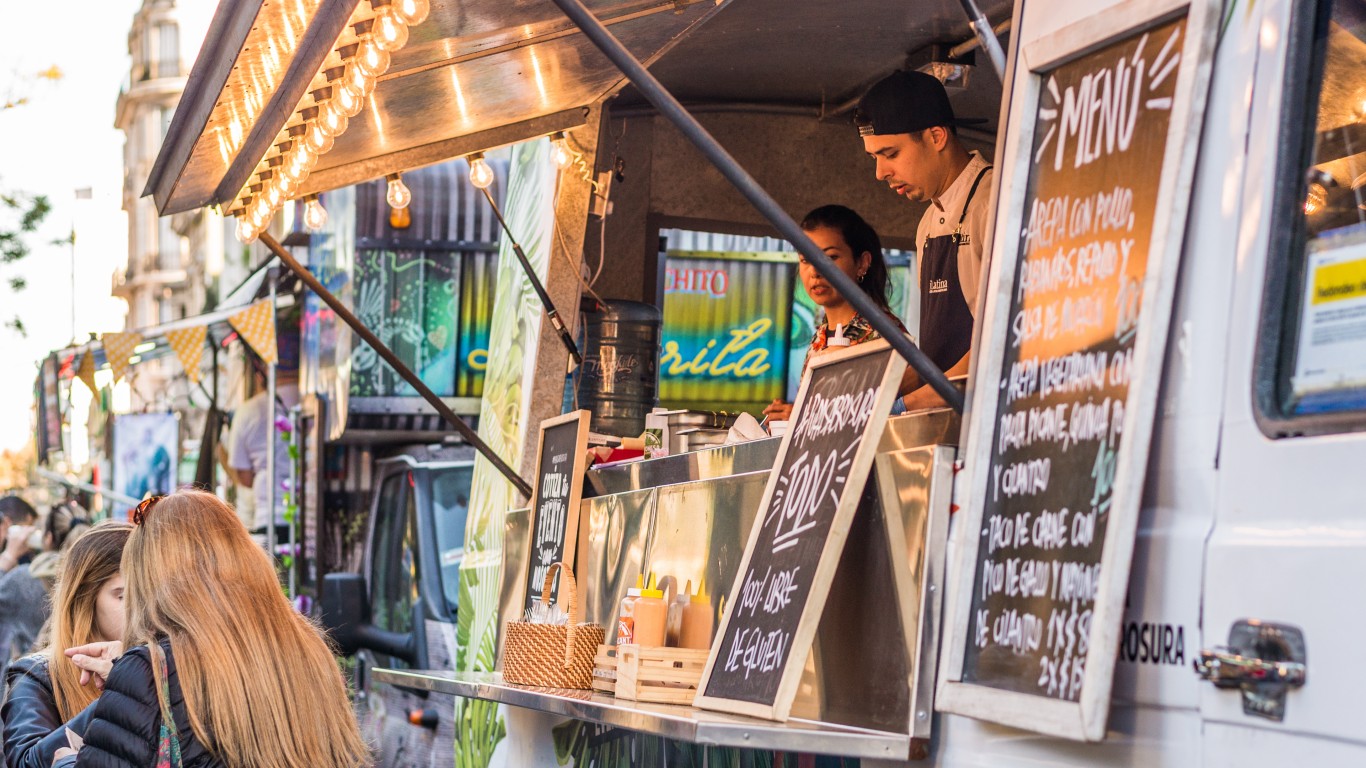
Food trucks
Mini-restaurants on wheels are old news in the sense of taco trucks and construction-site lunch wagons, but would-be restaurateurs didn’t embrace the idea until after L.A.-based Korean-American chef Roy Choi rolled out his first Kogi Truck in late 2008. Choi specialized in Korean-Mexican mashups, like his signature Korean short rib tacos, and promoted his enterprise on social media. As the website Food Truck Nation points out, Choi’s innovative spirit inspired “a diverse crowd of rich and poor [that] represent all races and genders” to launch their own trucks serving almost every kind of street food imaginable — pizza, sushi, barbecue, dim sum, gyros, arepas, bánh mì, and much, much more. The food truck industry has seen an average growth rate of 7.9% since 2011, and reported $2.7 billion in revenue in 2017.

Agave
Agave is a genus of succulent plants found mostly in the American Southwest, Mexico, and Central and tropical South America. It has become trendy in America in recent years in two forms: The first is as agave syrup, a natural sweetener that’s a popular honey substitute for vegans and also often recommended for diabetics due to its low glycemic index, meaning it’s less likely than other sweeteners to spike blood sugar (though long-term consumption has been linked to insulin resistance, which actually increases diabetes risk). Agave syrup is expected to enjoy a growth rate of 5.2% between last year and 2023. The other big agave category is mezcal. Though premium tequilas, made from one specific kind of agave, continue to be popular, its relative mezcal — which can be made from a number of different varieties — showed the largest gain of any spirit category for 2018 in the U.S., at 32.4%.
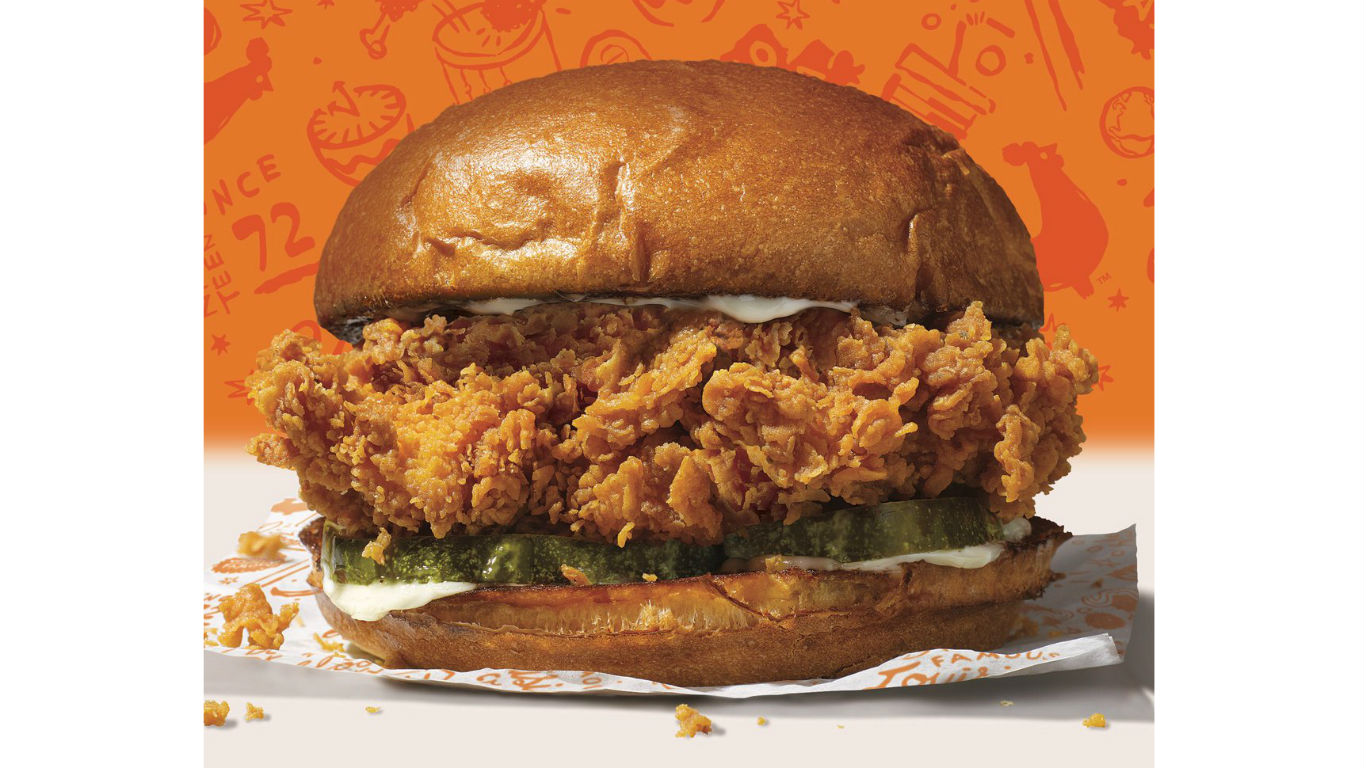
Chicken sandwiches
Sliced chicken deli sandwiches are fine, but what Americans really love these days is a slab of batter-coated fried chicken on a soft roll, typically with lettuce and mayo and often with pickle slices added. Fried chicken sandwiches predate 2010, but have only become a big thing in recent years. (One theory is that they got popular after the 2008 financial crisis, when people sought something cheap and comforting to eat.). Almost all the major chains now serve one or more versions — McDonalds, Burger King, Wendy’s, Hardee’s, Arby’s, Sonic, White Castle, KFC (of course), Shake Shack… and maybe most influentially of all right now, the protagonists in this summer’s “chicken wars” — Chick-fil-A (which claims to have invented the sandwich) and Popeyes Louisiana Kitchen (which sold so many of its new version that it ran out of chicken and took the sandwich off the menu for months).
[in-text-ad-2]
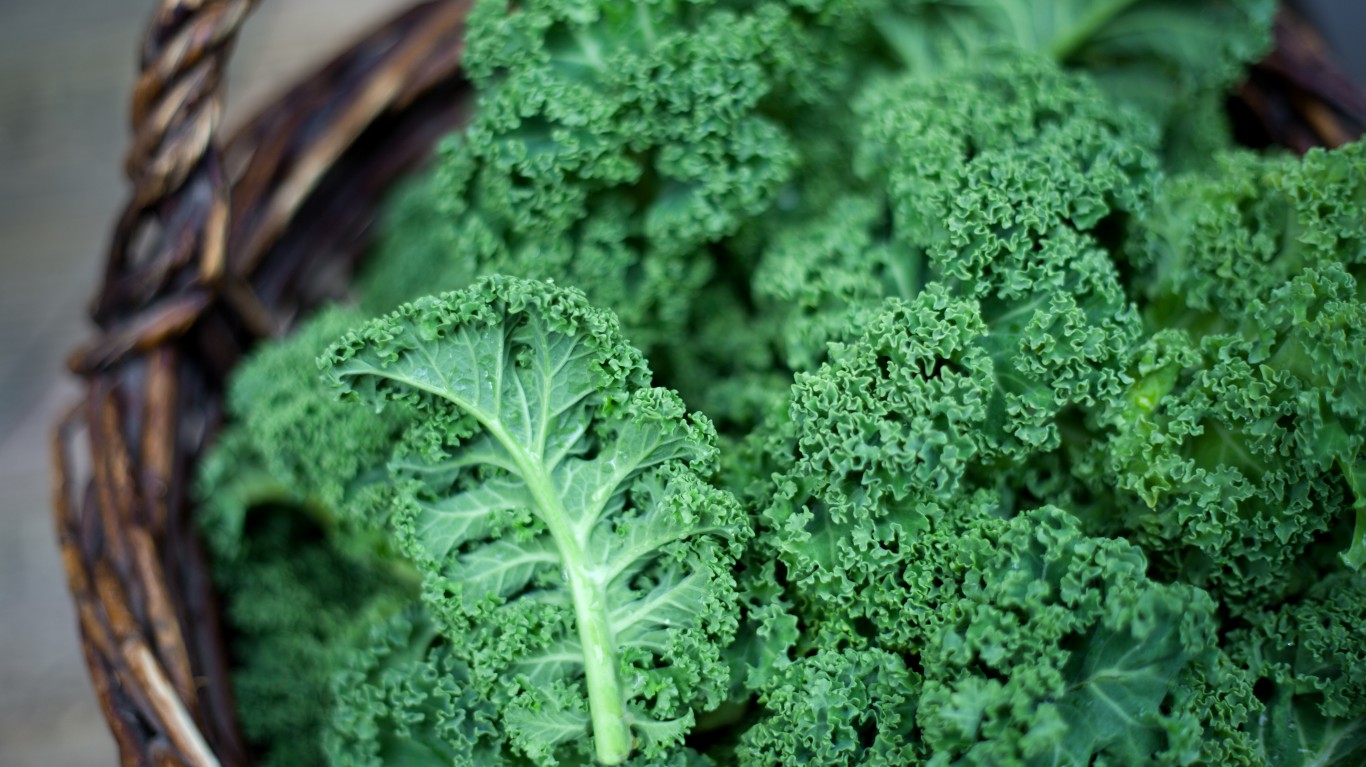
Kale
There are plenty of nutritious greens out there, like collards, Swiss chard, and mustard greens, so why has kale become such a star? Maybe it’s because it has a crisp, easy-to-remember name, or the fact that its rather stiff leaves can be transformed easily into chips. It probably also has something to do with the efforts of a New York City public relations firm and the subsequent shout-outs from people like Dr. Oz and Gwyneth Paltrow (who demonstrated making kale chips on “Ellen” in 2011). Whatever it was, U.S. kale production increased by almost 60% between 2007 and 2012. Kale is still everywhere, but it seemed to reach its peak in 2014, and according to the Produce Market Guide, sales dropped by 8 million pounds between 2016 and 2017
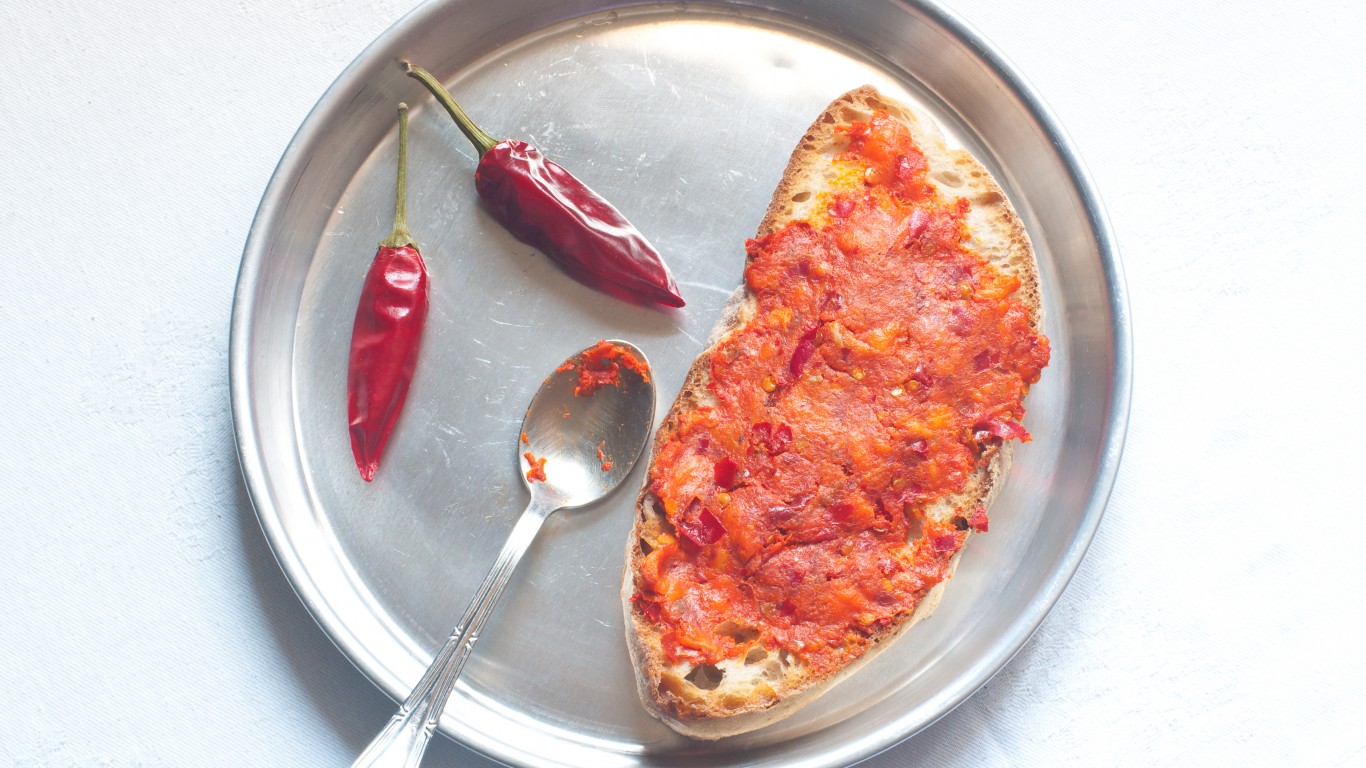
‘Nduja
A kind of soft, spicy sausage from the Italian regions of Calabria, made with pork fat, Calabrian chiles, and assorted herbs and spices, ‘nduja first started showing up on American menus in 2009 — but has been trending in a big way since the mid-2010s. (It is also big in the U.K. and Australia, as well as in its native country.) Either imported or domestically made, ‘nduja shows up these days in various places — for instance in pastas, on pizza, or blended with ground beef in burgers. At the upscale Middle Eastern restaurant Bavel in L.A. (see above), it’s even made with duck instead of pork and served atop hummus.
[in-text-ad]
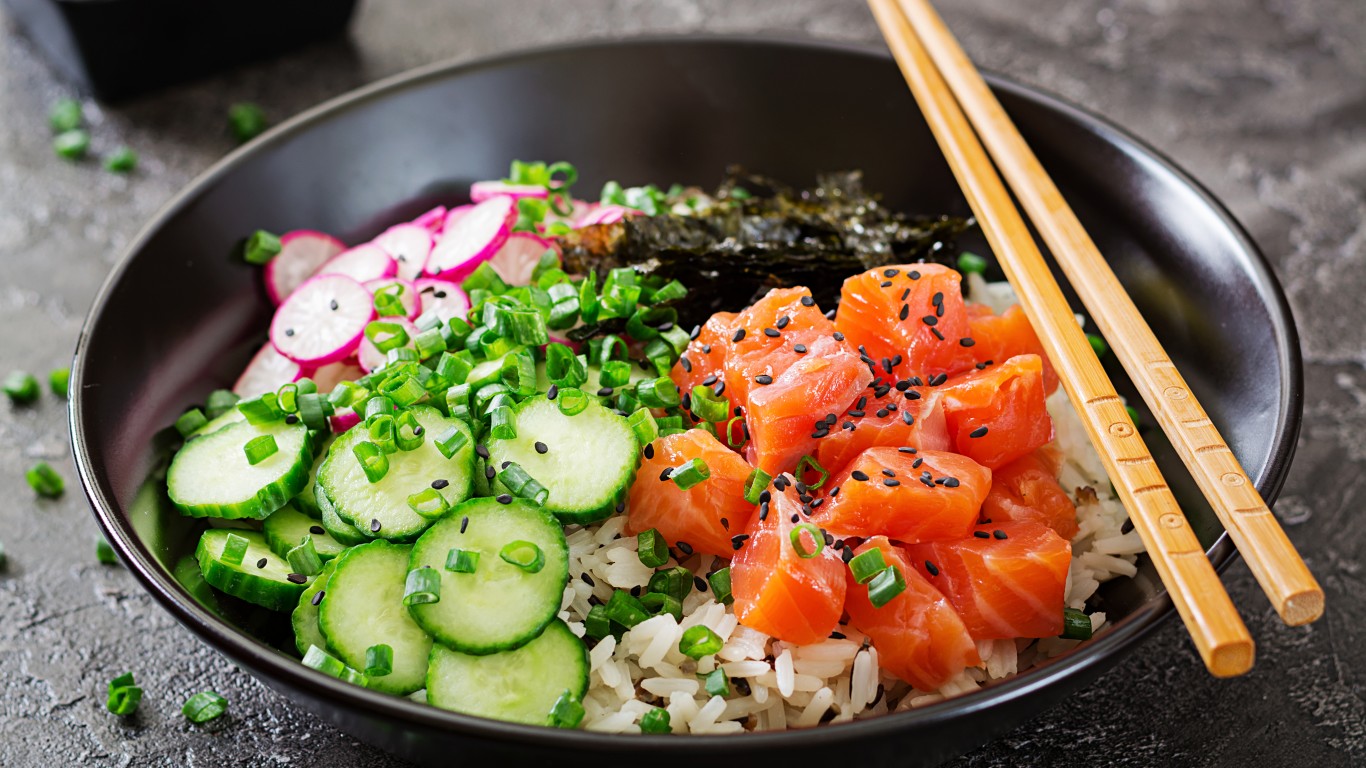
Poke
Poke (or poké — and pronounced “po-kay” in either case) is a traditional Hawaiian dish, made from cubes of raw ahi tuna, salmon, octopus, or other seafood marinated in soy sauce and sesame oil. Poke seems to have first appeared on the Mainland in 2015, when a small New York restaurant called Sons of Thunder put it on the menu and a New York Times restaurant critic hailed it. More poké shops opened in New York, and the idea spread quickly around the country. Poke is typically garnished with things like cucumber, avocado, and/or seaweed and served as a bowl (see above) over greens or rice — though it isn’t necessarily bowl food and can simply be presented on a plate.
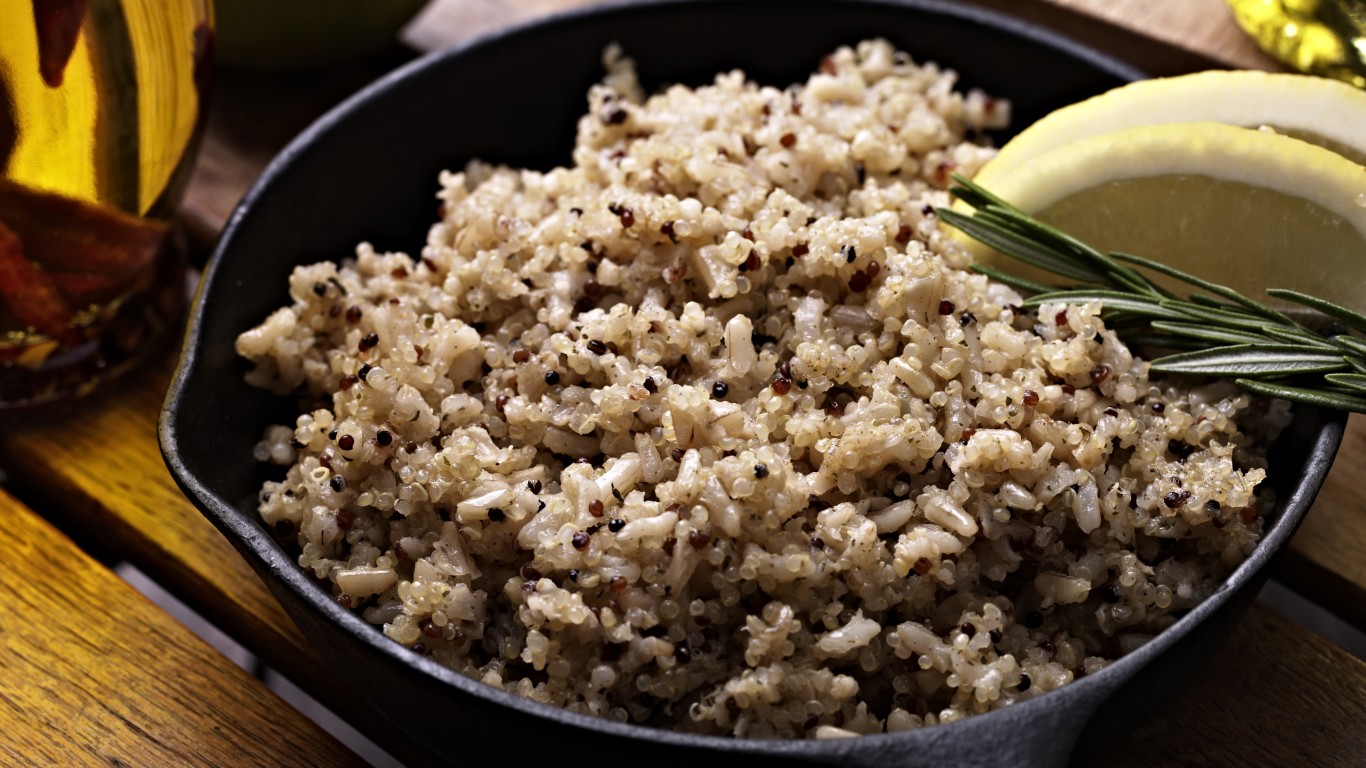
Quinoa
This dietary staple of the Andes — a highly nutritious grain-like seed (it is botanically considered a pseudocereal) — has been around for thousands of years, but it wasn’t until Oprah Winfrey publicized it as an element in her 21-day “cleanse” diet in 2008 that America really took notice.
In 2007, the U.S. imported 7.3 million pounds of quinoa; by 2013, that had grown to 60 million pounds. Last year, the total was almost 75 million.
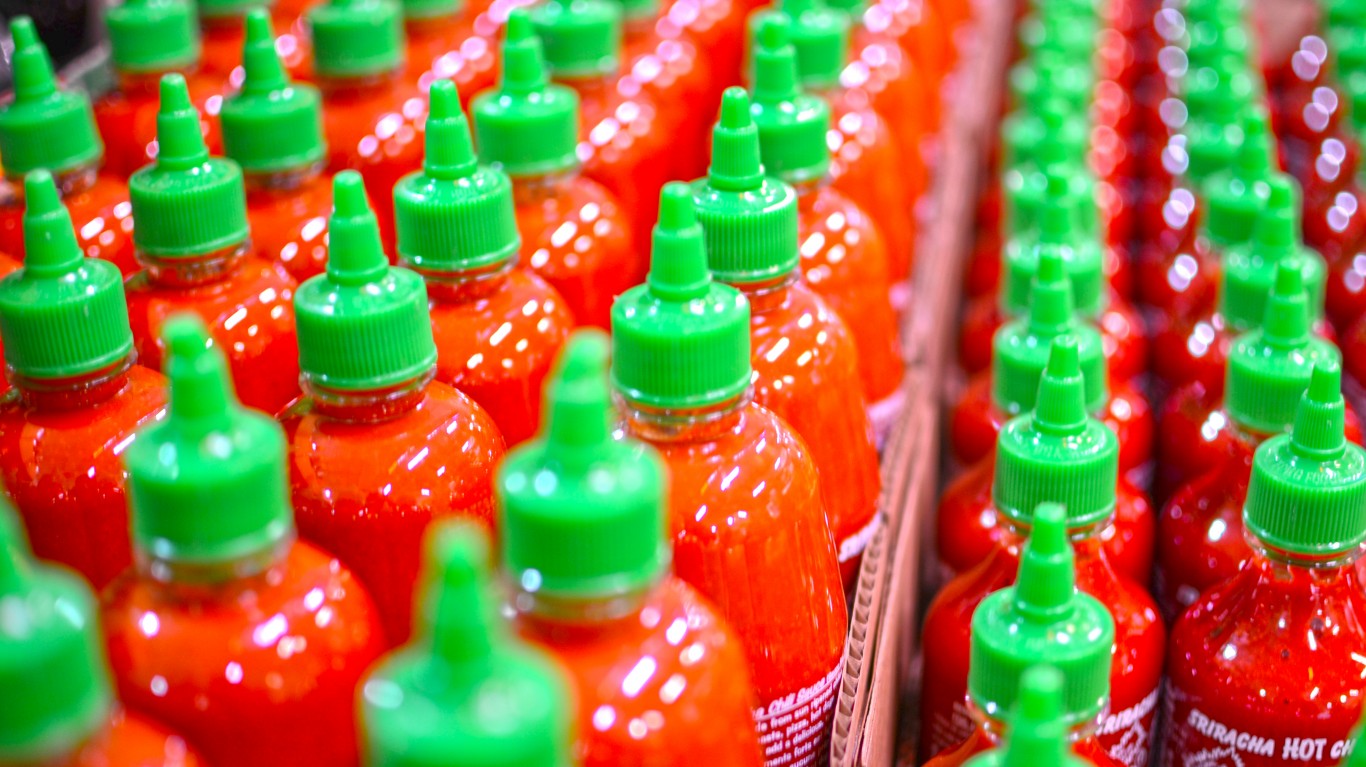
Sriracha
A sauce of chiles, garlic, and vinegar, once dubbed “hipster ketchup,” sriracha is Thai in origin but is now widely used as a condiment in the cuisines of Vietnam and other countries. The brand most often seen in the U.S., and the one that started the sriracha craze here, is Huy Fong, first sold in 1980. It didn’t start taking over American tables, though, until it was named Ingredient of the Year by Bon Appétit in 2010 and subsequently hailed by other publications. After major press coverage of a 2013 lawsuit over supposed chile fumes from the Huy Fong factory, the company launched a major P.R. effort that put it even more squarely in the public consciousness. In addition to the sauce itself, the company produces or has licensed such products as sriracha beef jerky, sunflower seeds, and popcorn — as well as actual sriracha-flavored ketchup.
[in-text-ad-2]

Sugar-free diets
Added (as opposed to naturally occurring) sugar is poison, according to Huffington Post contributor Dr. David Samadi, and other doctors, nutritionists, and scientists echo his contention. It’s no wonder that sugar-free diets have become a thing in recent years. Such regimens don’t just mean avoiding desserts and drinking your coffee black. Serious sugar-free dieters give up not only table sugar but honey, maple syrup, soft drinks, and some kinds of fruit (like bananas), among other things. Gwyneth Paltrow went sugar-free in 2010, so you know it must be a thing to do (though she has been known to backslide). Other famous folk who have given the diet a try include Kourtney Kardashian, Adele, Kate Hudson, and Alec Baldwin.
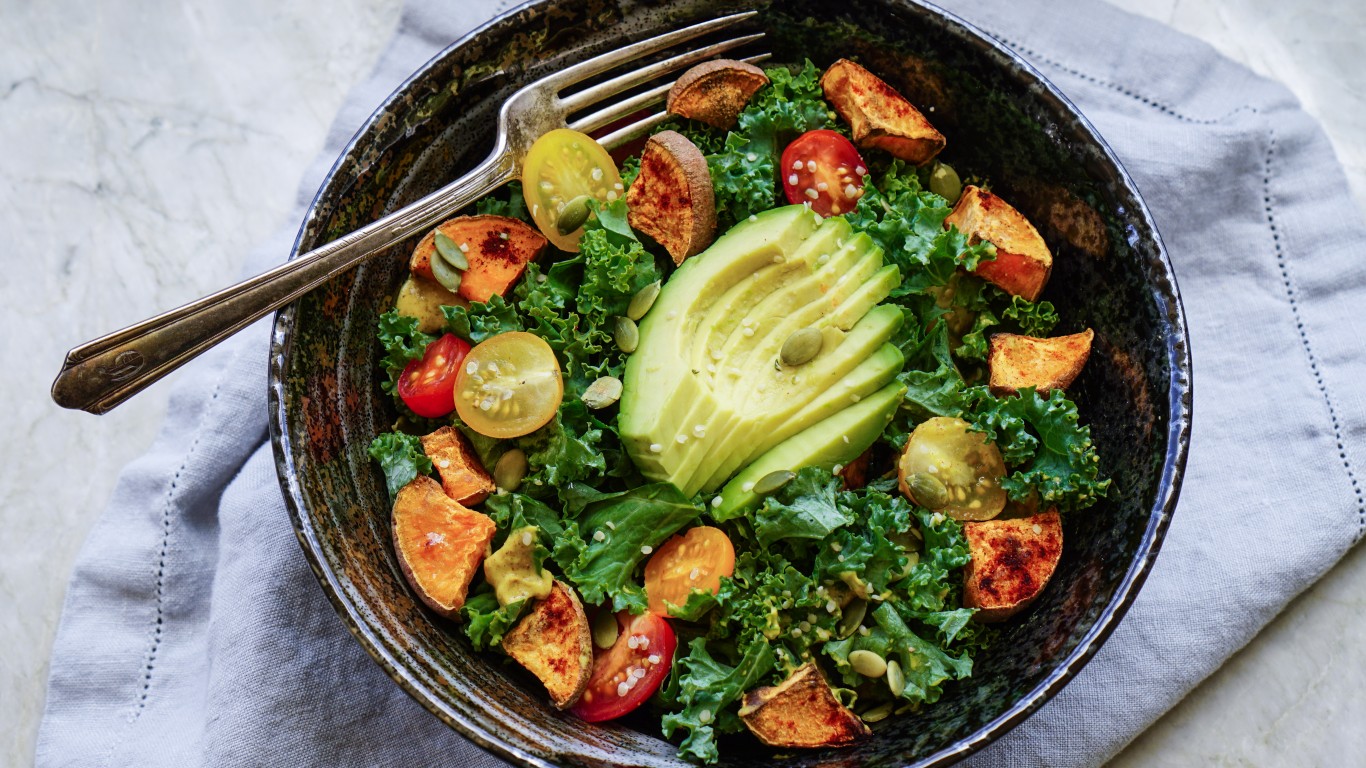
Paleo diet
The paleo diet (also called the caveman diet) was first proposed in 1975 by gastroenterologist Walter Voegtlin, an apparent white supremacist and eugenicist who proposed the mass slaughter of dolphins and tigers in the same book in which he recommended a diet based on plants and meat but eliminating dairy and grains on the grounds that our Paleolithic ancestors didn’t consume them. It got a boost from a more credible author in 1988, and many supporting publications appeared in the 2000s, but became a hot trend only in this decade, after such celebrities as Jessica Biel, Kobe Bryant, and Miley Cyrus advocated for it. It seems lost on paleo fans that however healthy our ancient ancestors might have been, their average life expectancy was 35 years.
[in-text-ad]
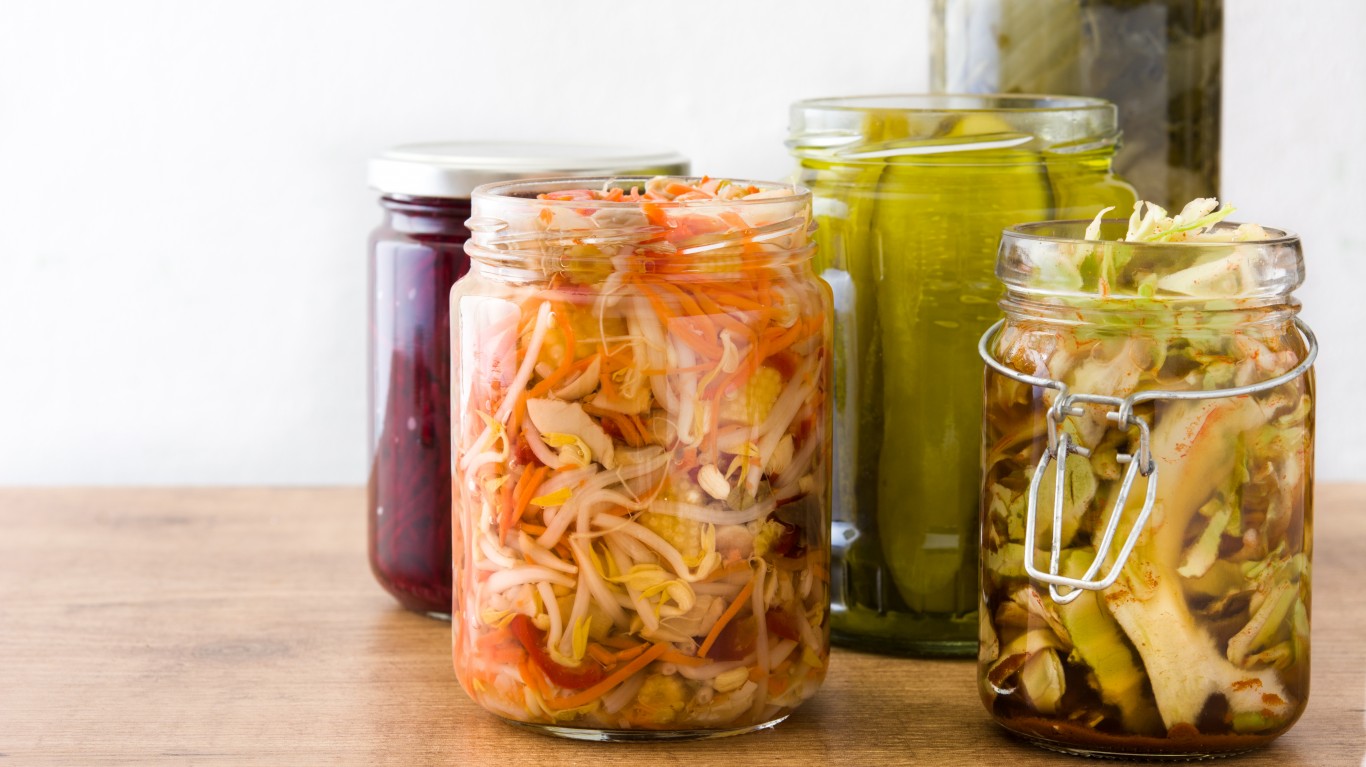
Probiotic foods
Probiotics — living organisms like bacteria and yeast that have reputed health benefits — have been around since prehistoric times, though the term dates only from the 1950s. Probiotics first became popular in the U.S. in the 1990s, but increased dramatically in popularity in the early 2010s. In 2007, only about 865,000 U.S. adults used probiotics or prebiotics (indigestible fibers on which bacteria feed), but by 2012 that number had reached close to 4 million. A 2015 survey found that they had become the third most commonly used dietary supplement in this country after fish oil and glucosamine and chondroitin (used to treat osteoarthritis).
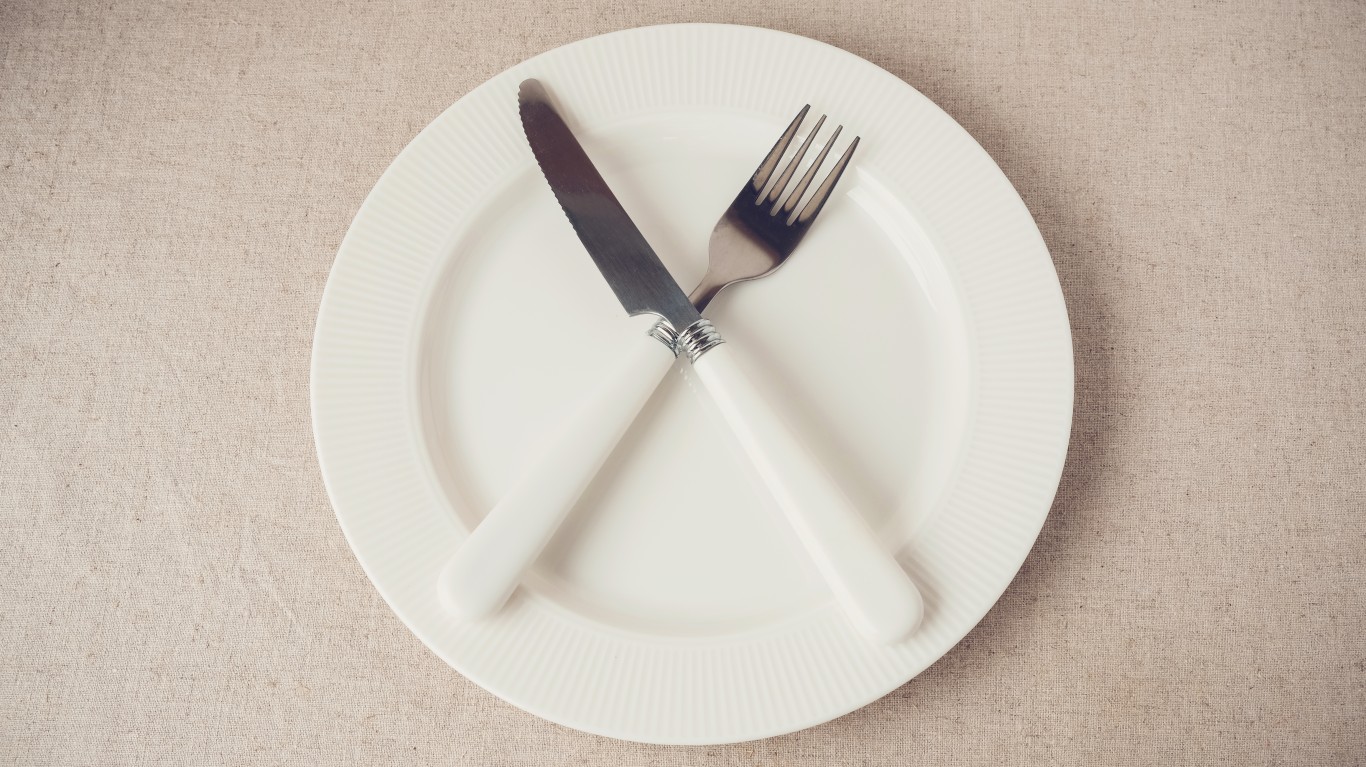
Intermittent fasting
The term “intermittent fasting” can mean various things, among them eating only one meal a day, restricting calorie intake substantially for two or three days a week (typically 500 calories for women, 600 for men), or following such eating patterns as 16:8 (condensing all the day’s food consumption into one eight-hour period and avoiding food for the other 16). The practice is thought to induce weight loss, lower the risk of developing type 2 diabetes, and even help prevent cancer, among other health benefits. Though people have fasted for eons — whether for reasons of health or religion or simply because enough food wasn’t available — but the modern-day trend began in England in 2010 and reached America several years later.
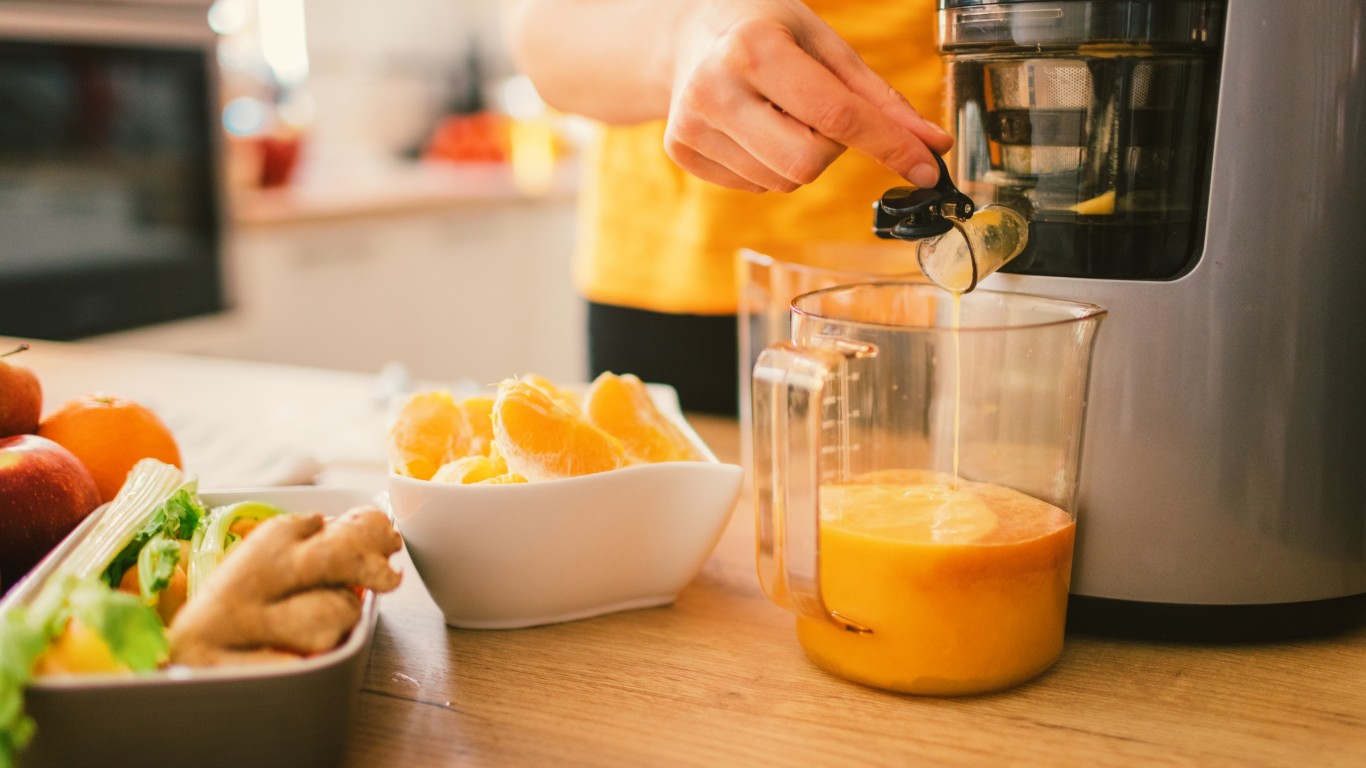
Juicing
Juicing is the practice of drinking only fruit and vegetable juices for days or even months at a time. This is said to help with weight loss and “detox” the system (the regimen is sometimes called a “juice cleanse”). Sales of expensive juicers — they can cost between $50 and $400 — soared 71% between 2011 and 2012. Some studies have reported that juicing isn’t all that healthy, but that hasn’t stopped such marquee names as Blake Lively, Colin Farrell, and the inevitable Gwyneth Paltrow from embracing the trend.
[in-text-ad-2]
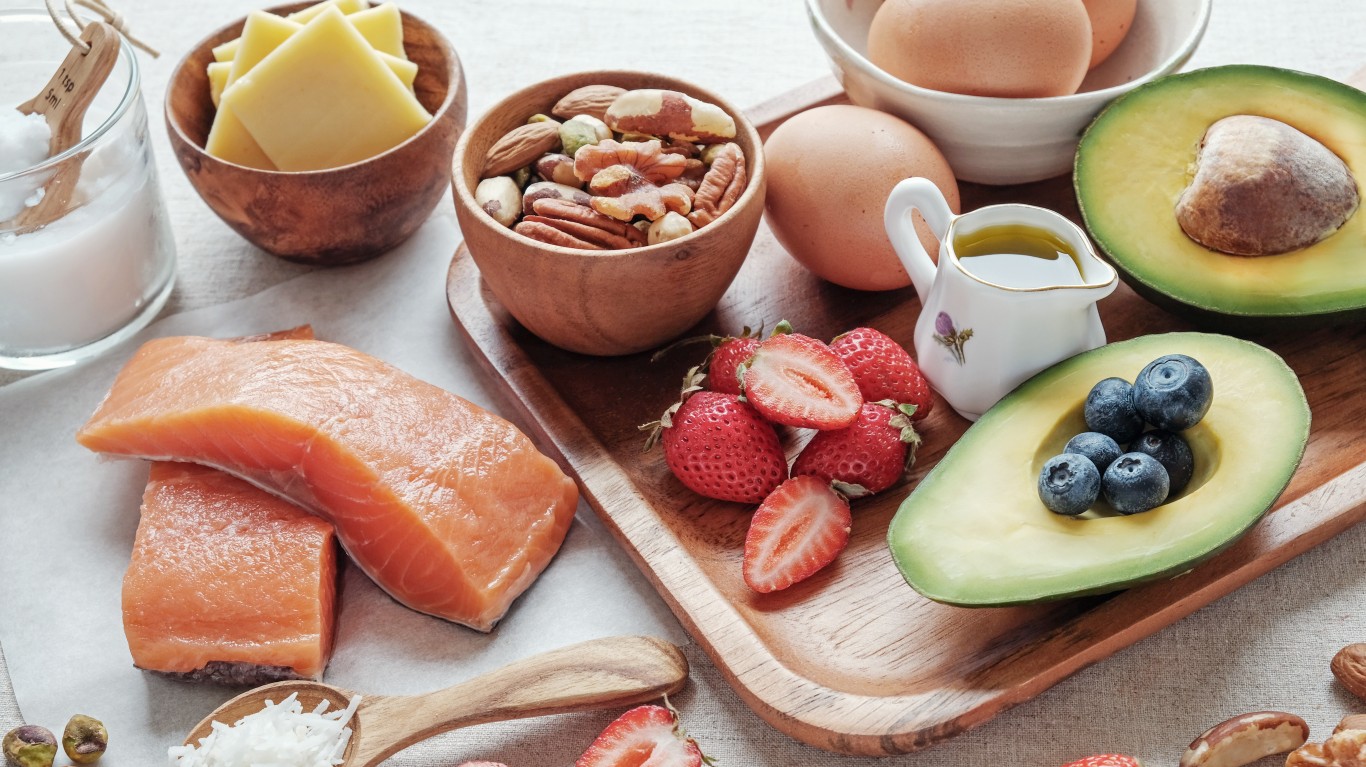
Keto eating
The keto diet, a high-fat regimen with severely limited carbohydrates, was originally developed as a treatment for epilepsy. “Keto” is short for ketogenic, meaning producing ketones — acidic chemicals released by the liver when the body has insufficient insulin. The standard version of the diet, which promotes weight loss and helps fight diabetes and other conditions, contains 75% fat, 20% protein, and only 5% carbs. Though some doctors warn that the diet could cause low blood pressure, nutritional deficiencies, and an increased risk of heart disease, among other things, keto was hailed as “the most popular diet of 2018,” with Google searches for the term far exceeding those for “paleo” or “intermittent fasting.”
The average American spends $17,274 on debit cards a year, and it’s a HUGE mistake. First, debit cards don’t have the same fraud protections as credit cards. Once your money is gone, it’s gone. But more importantly you can actually get something back from this spending every time you swipe.
Issuers are handing out wild bonuses right now. With some you can earn up to 5% back on every purchase. That’s like getting a 5% discount on everything you buy!
Our top pick is kind of hard to imagine. Not only does it pay up to 5% back, it also includes a $200 cash back reward in the first six months, a 0% intro APR, and…. $0 annual fee. It’s quite literally free money for any one that uses a card regularly. Click here to learn more!
Flywheel Publishing has partnered with CardRatings to provide coverage of credit card products. Flywheel Publishing and CardRatings may receive a commission from card issuers.
Thank you for reading! Have some feedback for us?
Contact the 24/7 Wall St. editorial team.